Arthur Conan Doyle
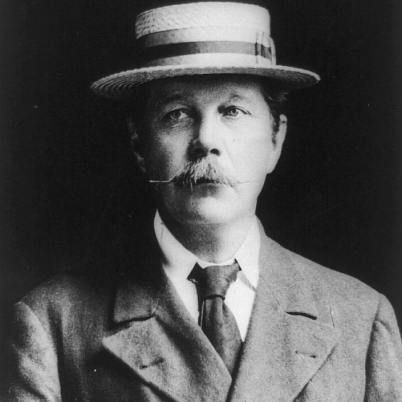
(1859-1930)

Who Was Arthur Conan Doyle?
In 1890, Arthur Conan Doyle's novel, A Study in Scarlet introduced the character of Detective Sherlock Holmes. Doyle would go on to write 60 stories about Sherlock Holmes. He also strove to spread his Spiritualism faith through a series of books that were written from 1918 to 1926. Doyle died of a heart attack in Crowborough, England on July 7, 1930.
On May 22, 1859, Arthur Conan Doyle was born to an affluent, strict Irish-Catholic family in Edinburgh, Scotland. Although Doyle's family was well-respected in the art world, his father, Charles, who was a life-long alcoholic, had few accomplishments to speak of. Doyle's mother, Mary, was a lively and well-educated woman who loved to read. She particularly delighted in telling her young son outlandish stories. Her great enthusiasm and animation while spinning wild tales sparked the child's imagination. As Doyle would later recall in his biography, "In my early childhood, as far as I can remember anything at all, the vivid stories she would tell me stand out so clearly that they obscure the real facts of my life."
At the age of 9, Doyle bid a tearful goodbye to his parents and was shipped off to England, where he would attend Hodder Place, Stonyhurst — a Jesuit preparatory school — from 1868 to 1870. Doyle then went on to study at Stonyhurst College for the next five years. For Doyle, the boarding-school experience was brutal: many of his classmates bullied him, and the school practiced ruthless corporal punishment against its students. Over time, Doyle found solace in his flair for storytelling and developed an eager audience of younger students.
Medical Education and Career
When Doyle graduated from Stonyhurst College in 1876, his parents expected that he would follow in his family's footsteps and study art, so they were surprised when he decided to pursue a medical degree at the University of Edinburgh instead. At med school, Doyle met his mentor, Professor Dr. Joseph Bell, whose keen powers of observation would later inspire Doyle to create his famed fictional detective character, Sherlock Holmes. At the University of Edinburgh, Doyle also had the good fortune to meet classmates and future fellow authors James Barrie and Robert Louis Stevenson. While a medical student, Doyle took his own first stab at writing, with a short story called The Mystery of Sasassa Valley . That was followed by a second story, The American Tale , which was published in London Society .
During Doyle's third year of medical school, he took a ship surgeon's post on a whaling ship sailing for the Arctic Circle. The voyage awakened Doyle's sense of adventure, a feeling that he incorporated into a story, Captain of the Pole Star .
In 1880, Doyle returned to medical school. Back at the University of Edinburgh, Doyle became increasingly invested in Spiritualism or "Psychic religion," a belief system that he would later attempt to spread through a series of his written works. By the time he received his Bachelor of Medicine degree in 1881, Doyle had denounced his Roman Catholic faith.
Doyle's first paying job as a doctor took the form of a medical officer's position aboard the steamship Mayumba, traveling from Liverpool to Africa. After his stint on the Mayumba, Doyle settled in Plymouth, England for a time. When his funds were nearly tapped out, he relocated to Portsmouth and opened his first practice. He spent the next few years struggling to balance his burgeoning medical career with his efforts to gain recognition as an author. Doyle would later give up medicine altogether, in order to devote all of his attention to his writing and his faith.
Personal Life
In 1885, while still struggling to make it as a writer, Doyle met and married his first wife, Louisa Hawkins. The couple moved to Upper Wimpole Street and had two children, a daughter and a son. In 1893, Louisa was diagnosed with tuberculosis. While Louisa was ailing, Doyle developed an affection for a young woman named Jean Leckie. Louisa ultimately died of tuberculosis in Doyle's arms, in 1906. The following year, Doyle would remarry to Jean Leckie, with whom he would have two sons and a daughter.
Books: Sherlock Holmes
In 1886, newly married and still struggling to make it as an author, Doyle started writing the mystery novel A Tangled Skein . Two years later, the novel was renamed A Study in Scarlet and published in Beeton's Christmas Annual . A Study in Scarlet , which first introduced the wildly popular characters Detective Sherlock Holmes and his assistant, Watson, finally earned Doyle the recognition he had so desired. It was the first of 60 stories that Doyle would pen about Sherlock Holmes over the course of his writing career. Also, in 1887, Doyle submitted two letters about his conversion to Spiritualism to a weekly periodical called Light .
Doyle continued to actively participate in the Spiritualist movement from 1887 to 1916, during which time he wrote three books that experts consider largely autobiographical. These include Beyond the City (1893), The Stark Munro Letters (1895) and A Duet with an Occasional Chorus (1899). Upon achieving success as a writer, Doyle decided to retire from medicine. Throughout this period, he additionally produced a handful of historical novels including one about the Napoleonic Era called The Great Shadow in 1892, and his most famous historical novel, Rodney Stone , in 1896.
The prolific author also composed four of his most popular Sherlock Holmes books during the 1890s and early 1900s: The Sign of Four (1890), The Adventures of Sherlock Holmes (1892), The Memoirs of Sherlock Holmes (1894) and The Hound of Baskervilles , published in 1901. In 1893, to Doyle's readers' disdain, he had attempted to kill off his Sherlock Holmes character in order to focus more on writing about Spiritualism. In 1901, however, Doyle reintroduced Sherlock Holmes in The Hound of Baskervilles and later brought him back to life in The Adventure of the Empty House so the lucrative character could earn Doyle the money to fund his missionary work. Doyle also strove to spread his faith through a series of written works, consisting of The New Revolution (1918), The Vital Message (1919), The Wanderings of a Spiritualist (1921) and History of Spiritualism (1926).
In 1928, Doyle's final twelve stories about Sherlock Holmes were published in a compilation entitled The Casebook of Sherlock Holmes .
Having recently been diagnosed with Angina Pectoris, Doyle stubbornly ignored his doctor's warnings, and in the fall of 1929, embarked on a spiritualism tour through the Netherlands. He returned home with chest pains so severe that he needed to be carried on shore and was thereafter almost entirely bedridden at his home in Crowborough, England. Rising one last time on July 7, 1930, Doyle collapsed and died in his garden while clutching his heart with one hand and holding a flower in the other.
QUICK FACTS
- Name: Arthur Conan Doyle
- Birth Year: 1859
- Birth date: May 22, 1859
- Birth City: Edinburgh
- Birth Country: Scotland
- Gender: Male
- Best Known For: Author Arthur Conan Doyle wrote 60 mystery stories featuring the wildly popular detective character Sherlock Holmes and his loyal assistant Watson.
- Journalism and Nonfiction
- Fiction and Poetry
- Astrological Sign: Gemini
- Hodder Place, Stonyhurst
- Stonyhurst College
- University of Edinburgh
- Nacionalities
- Scot (Scotland)
- Death Year: 1930
- Death date: July 7, 1930
- Death City: Crowborough
- Death Country: United Kingdom
CITATION INFORMATION
- Article Title: Arthur Conan Doyle Biography
- Author: Biography.com Editors
- Website Name: The Biography.com website
- Url: https://www.biography.com/authors-writers/arthur-conan-doyle
- Access Date:
- Publisher: A&E; Television Networks
- Last Updated: June 17, 2020
- Original Published Date: April 3, 2014
- Where there is no imagination there is no horror.
Famous British People

Mick Jagger

Agatha Christie

Alexander McQueen

The Real Royal Scheme Depicted in ‘Mary & George’

William Shakespeare

Anya Taylor-Joy

Kate Middleton, Princess of Wales

Kensington Palace Shares an Update on Kate

Amy Winehouse

Prince William

Where in the World Is Kate Middleton?
Biography Online

Sir Arthur Conan Doyle Biography
Sir Arthur Conan Doyle (22 May 1859 – 7 July 1930) – Scottish writer, physician and spiritualist – best known for his Sherlock Holmes stories.
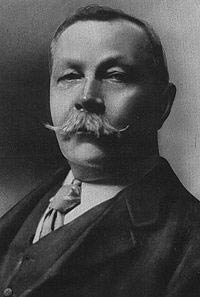
After his father’s death, the burden of supporting a large family fell on Arthur Conan Doyle. To supplement his income he began writing short stories. His first story of note was A Study in Scarlet published in the Beeton’s Christmas Annual 1887 (featuring the first appearance of Sherlock Holmes. This later led to a contract writing more Sherlock Holmes stories for the Strand magazine. It was in these early stories that he developed the character of Sherlock Holmes. It was a character that fascinated the reading public and he soon became one of the best-loved fictional characters. Sherlock Holmes always had an element of mystery – the sharpest mind and his unbelievable powers of observation.
“…when you have eliminated the impossible, whatever remains, however improbable, must be the truth…”
-Sir Arthur Conan Doyle, (Sherlock Holmes)
Sherlock Holmes also had his share of human weaknesses such as smoking and drug addiction. His partner, the sensible, loyal Watson proved the ideal counterbalance to the highly strung genius of Holmes.
The success of Sherlock Holmes enabled Conan Doyle to retire from his medical profession and become a full-time writer. But, it was not the popular Sherlock Holmes stories which inspired him the most. He was more interested in writing serious historical novels and becoming known as a famous writer in this genre. However, his historical novels never brought him the same financial remuneration or fame as his Sherlock Holmes stories did.
After a while, Doyle became increasingly frustrated with the public’s obsession with Holmes, at a time when he was growing weary of the stories. Therefore, he decided to retire Holmes in 1893 by having him plunge into a ravine with his arch-enemy Professor Moriarty. Holmes hoped this would give him more time to write his ‘serious novels’ – but, much to his frustration, he struggled to escape the public’s perception of him as the creator of Holmes. In fact, it wasn’t uncommon for members of the public to equate Conan Doyle with Sherlock Holmes – much to his annoyance.
In 1900, Conan Doyle served in a field hospital in the Boer war. He also later published a pamphlet The War in South Africa: Its Cause and Conduct , which sought to justify British actions in the unpopular Boer war. For his services in the war, he was knighted, though undoubtedly his fame as the creator of Sherlock Holmes was also a factor.
In, 1906, his first wife, Louisa Hawkins, died after a long battle with Tuberculosis. It was a big blow to Conan Doyle who had moved to Switzerland to help her health.
After getting married to his second wife, Denise Steward a year later, he again was in the need for more money to finance a lavish new family home. Again, Doyle turned to his ever-profitable Holmes, securing a great deal with an American publisher for more Holmes stories. Thus, Holmes was resurrected, Conan Doyle cleverly wrote that Holmes had never died in the fall but cunningly escaped Moriarty and had gone into hiding from his enemies.
Conan Doyle’s most famous character was a man of great reason and science, so it was perhaps ironical that Conan Doyle was to become greatly interested in the new religion of spiritualism. A large part of spiritualism was the contacting of deceased relatives through seances. For many years, Conan Doyle had toyed with the ideas, but the traumatic years of the First World War (where he lost a brother and son) changed his outlook to that of a fervent believer. Conan Doyle became one of the chief proponents and public faces for spiritualism. Conan Doyle felt that this proof of life beyond death could give fresh impetus to religion.
“Religions are mostly petrified and decayed, overgrown with forms and choked with mysteries. We can prove that there is no need for this. All that is essential is both very simple and very sure.” ( The New Revelation 1918)
The success of Conan Doyle’s Holmes enabled him to pursue many different interests. As well, as researching spiritualism, Conan Doyle found time to fight miscarriages of justice such as the George Edalji case.
“I should dearly love that the world should be ever so little better for my presence. Even on this small stage, we have our two sides, and something might be done by throwing all one’s weight on the scale of breadth, tolerance, charity, temperance, peace, and kindliness to man and beast. We can’t all strike very big blows, and even the little ones count for something.”
Arthur Conan Doyle, Stark Munro Letters (1894)
Citation: Pettinger, Tejvan . “ Biography of Sir Arthur Conan Doyle ”, Oxford, UK. www.biographyonline.net. Published 25th June 2009. Last updated 15 February 2018.
The Doctor and the Detective: A Biography of Sir Arthur Conan Doyle
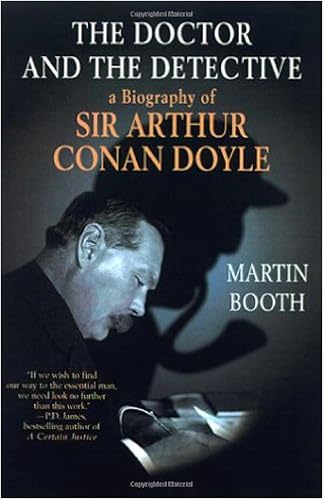
The Doctor and the Detective: A Biography of Sir Arthur Conan Doyle at Amazon
The Complete Sherlock Holmes

The Complete Sherlock Holmes at Amazon
Related pages
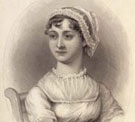
Not logged in
Page actions.
- View source
Arthur Conan Doyle (22 May 1859 - 7 July 1930). M.D., Kt, KStJ, D.L., LL.D. , Writer, Sportsman, Artist, Poet, Politician, Business man, Justicer, Inventor, Patriot, Spiritualist...
The Arthur Conan Doyle Encyclopedia is an online repository of all works written by Sir Arthur Conan Doyle ( fictions , essays , articles , poems , plays , lectures , letters , manuscripts ...), but also any materials related to him ( newspaper articles , interviews , photos , movies ...).
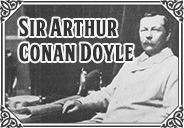
Adaptations
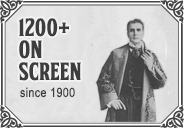
Conan Doyle: Mystery and Adventure
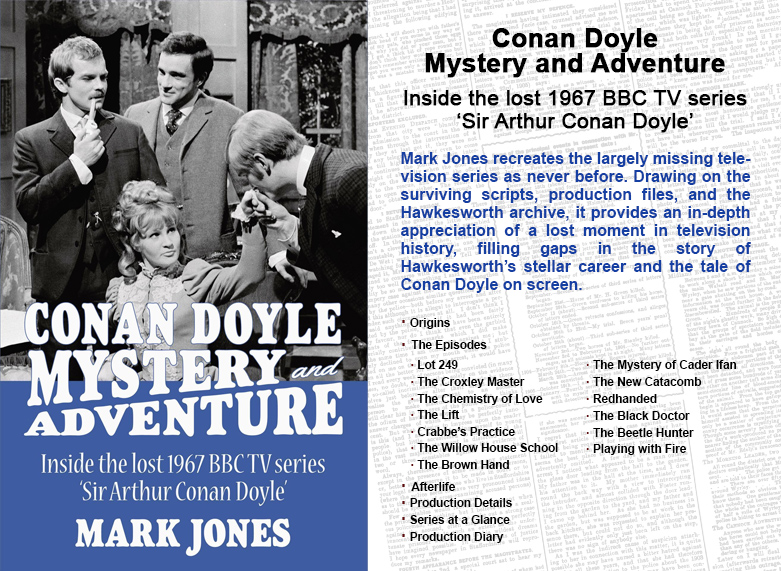
New Book: My Own Story, by George Edalji
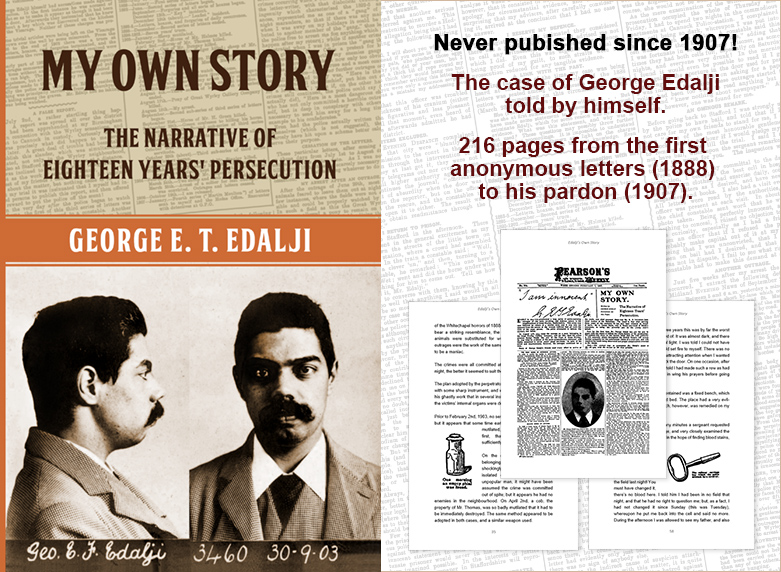
Doings of Doyle: Podcast

A Chronology of the Life of Arthur Conan Doyle: New Edition
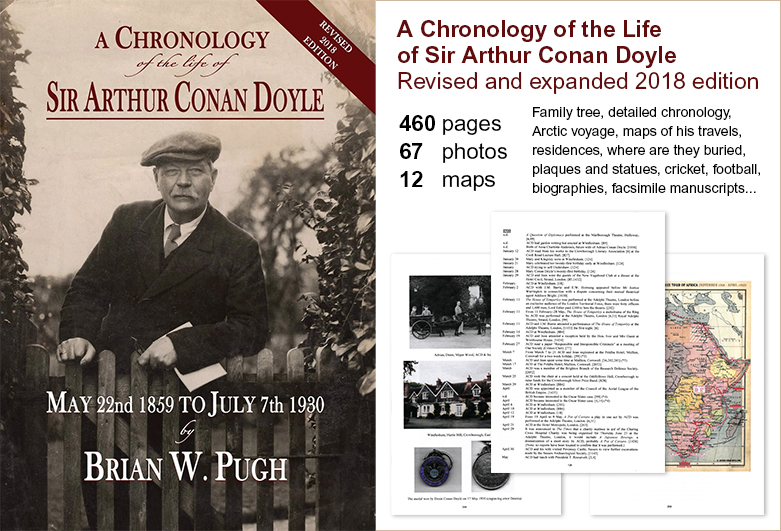
- Sir Arthur Conan Doyle
- A Life in Pictures
- A Life in Movies
- Sherlock Holmes
- Brigadier Gerard
- Sir Nigel Loring
- Captain Sharkey
- All fictions
- Search Fictions
- Essays, Articles
- His Handwriting
- Manuscripts
- Drawings & Paintings
- Illustrators
- Periodicals
Contact/Support
- Special pages
- Cite this page
User page tools
- What links here
- Related changes
- Printable version
- Permanent link
- Page information
- This page was last modified on 9 April 2024, at 23:52.
- Privacy policy
- About The Arthur Conan Doyle Encyclopedia
- Disclaimers
Arthur's parents, Mary Foley Doyle and Charles Altamont Doyle, had moved to Scotland from London, hoping that Charles could advance his career in architecture. Having inherited some measure of his family's artistic talent, Charles began with every hope of success, but never realized his dreams. Plagued by depression and alcoholism, Charles was a distant father and husband, becoming so detached from reality that he ended life in an asylum. With considerable charity, his son Arthur later said of him, "My father's life was full of the tragedy of unfulfilled powers and of underdeveloped gifts."
By this time, Charles Doyle had lost his job, and the family had difficulty paying the school fees. A lodger named Bryan Charles Waller became the family's protector, eventually supporting Mary, Charles, and their children completely.
Once at university, Conan Doyle found the work difficult and boring. He gained more amusement from playing sports, at which he excelled, than in listening to lectures in large, crowded lecture halls. More interesting than studying was describing his instructors' eccentric personalities. Among his teachers was the man Conan Doyle later acknowledged as his inspiration for Sherlock Holmes, Dr. Joseph Bell. Dr. Bell taught his students the importance of observation, using all the senses to obtain an accurate diagnosis. He enjoyed impressing students by guessing a person's profession from a few indications, through a combination of deductive and inductive reasoning, like Holmes. Although Bell's methods fascinated Conan Doyle, his cold indifference towards his patients repelled the young medical student. Some of this coldness found its way into Sherlock Holmes's character, especially in the early stories.
In 1886, Doyle finished the first Sherlock Holmes novella, A Study in Scarlet . After several rejections, he was forced to sell it outright for £25 for inclusion in the 1887 Beeton's Christmas Annual, a holiday collection that often sold out, but did not usually attract much attention in the national press. The work was reprinted in 1889 and many more times, but Conan Doyle never earned another penny from it. Sign of the Four , the second work to feature Holmes and Watson, also achieved a small, but by no means brilliant, success.
While writing the early Holmes stories, Doyle also began what he considered his most important work: chivalric, historical novels based on British history, primarily, Micah Clark, Sir Nigel, and The White Company . Although these novels were widely admired, none of them created the stir caused by the first series of short stories featuring Sherlock Holmes and John Watson that appeared in The Strand Magazine , starting in 1891. Despite their overwhelming success, Conan Doyle never suspected that these stories would be the foundation of his literary legacy.
After writing three series of twelve Holmes stories, receiving the unheard-of sum of £1000 for the last dozen, Conan Doyle was sick to death of the popular detective and decided to kill him off in the 1893 story, "The Final Problem." Conan Doyle considered the Holmes stories light fiction, good for earning money, but destined to be quickly forgotten, the literary equivalent of junk food. "I couldn't revive him if I would, at least not for years," he wrote to a friend who urged Holmes's resurrection, "for I have had such an overdose of him that I feel towards him as I do towards pâté de foie gras , of which I once ate too much, so that the name of it gives me a sickly feeling to this day." The vehement public reaction to Holmes's death must have shocked Conan Doyle. People wore black armbands and wrote him pleading--or threatening--letters. Still, it was nine years before he capitulated to public opinion and brought Holmes back. The third Holmes novel, The Hound of the Baskervilles , appeared in nine parts in The Strand Magazine during 1901-2, but it was presented as an old case from Watson's records, completed before Holmes's death. Conan Doyle did not make up his mind to resurrect Holmes until 1903, when he wrote "The Empty House." He continued, reluctantly, to produce Holmes stories until 1927, three years before his own death. Conan Doyle became an important public figure, twice standing (unsuccessfully) for Parliament. He was knighted for his efforts on behalf of the Boer War, both as the author of a persuasive, pro-war book and as a volunteer, caring for wounded British soldiers in the field. He even took on several real-life mysteries, using Holmes's methods and his own status as a famous author to free two unjustly imprisoned men. The First World War tore apart Conan Doyle's familiar world. Like so many others, he lost close family members to the conflict. Conan Doyle's brother-in-law and nephew died in combat, while the influenza pandemic took his brother Innes and his eldest son Kingsley, weakened by war wounds. During the war, he managed to have himself appointed as an observer for the Foreign Office, but he was kept away from the horrors of the western front for fear that he might reveal to the public things that the military would rather have kept quiet. Even Sherlock Holmes served England in the war. In the story that Conan Doyle intended to be the last Holmes outing, His Last Bow , published in 1916, Holmes outwits a German spy. Conan Doyle found a refuge from the horrors of the war, and he clung to it tenaciously. Starting in 1916, he publicly declared himself a spiritualist, and over the next few years he made spiritualism the center of his life, writing on the subject and traveling all over the world to advocate his beliefs. Never afraid to take an unpopular stand, Conan Doyle wrote a book in 1922 called The Coming of the Fairies , in which he defended the veracity of two young girls who claimed to have photographed each other playing with actual fairies and goblins.
Towards the end of their lives, long after Conan Doyle's death, the aged "girls" admitted to having used paper cutouts as stand-ins for the fairies. Interestingly, Conan Doyle's own Uncle Richard had invented, in his book illustrations, the typical representation of a fairy as a little girl with dragonfly wings and a gossamer gown. No matter how many times Conan Doyle was tricked by mediums later proven to be dishonest, he continued to believe in spiritualism. The famous American magician Harry Houdini made a project of trying to convince Conan Doyle of his error, but all he managed to do was ruin their friendship. Houdini saw spiritualism as cruel because it gave people false hope; Conan Doyle, who was already suffering from serious heart disease, wanted to believe that death was a grand new adventure. He fought his infirmity, trying to continue writing and traveling as before. He died at the age of 71, secure in his spiritualist beliefs.
Doctor, writer, believer in the supernatural--Conan Doyle's personality encompassed all these traits that contributed to the Sherlock Holmes stories we love to read today. Conan Doyle's fanciful imagination, combined with his scientific training, created ideas that have helped to shape the modern mystery and science fiction genres. One of the first to anticipate the dangers of submarines in warfare, he wrote a Sherlock Holmes story on the subject. His novel The Lost World is the ancestor of Jurassic Park and countless other films. Another of his stories, "The Ring of Thoth," was probably the plot source of the 1932 film The Mummy with Boris Karloff. An 1883 medical article called "Life and Death in the Blood," outlining the imaginary voyage of a microscopic observer through the human body, anticipated the main idea behind the film Fantastic Voyage . Conan Doyle's most long-lived idea, however, was Sherlock Holmes himself, who has continued to evolve in our time through the works of other writers and filmmakers, taking forms even his creator could never have imagined.
Conan Doyle wrote the Holmes stories quickly, never imagining that they would receive much scrutiny. If he forgot a date or fact from a previous story, he forged ahead without looking it up. This bad habit has resulted in some startling discrepancies. Was Watson wounded in the leg or the arm? How could Watson's deceased wife be on a visit to her mother's? Is Watson's given name "James" or "John"? To correct these and other inconsistencies, Sherlockians comb the "canon," or "sacred writings," for clues, seek secondary sources (inventing some themselves when all else fails), and write "scholarly" articles, using Holmes's methods to solve contradictions in the works or following clues to add new "facts" to Holmes's and Watson's biographies.
One favorite Sherlockian controversy centers on the "original" location of 221b Baker Street, a non-existent address in Conan Doyle's time. When Baker Street was renumbered during the 1920s, 221b was created on the block formerly called Upper Baker Street. Many faithful representations of the sitting room at 221b Baker Street have been constructed throughout the world. All contain the violin, the tobacco-holding Persian slipper, and other Holmesian accouterments mentioned in the stories.
Sir Arthur Conan Doyle. A Biographical Introduction
Dr andrzej diniejko , d. litt.; contributing editor, poland.
[ Victorian Web Home —> Visual Arts —> Authors —> Arthur Conan Doyle —> Next ]
Introduction
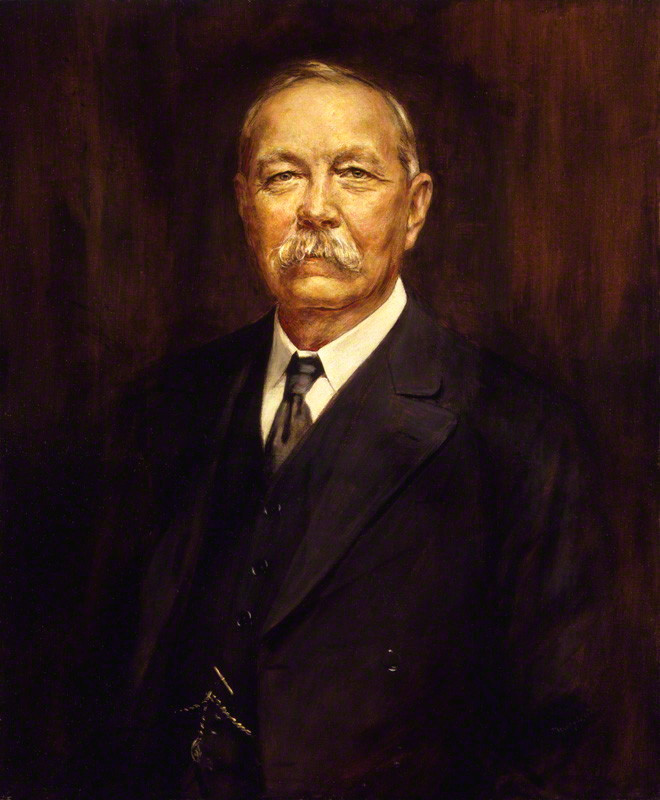
Sir Arthur Conan Doyle is known all over the world as the creator of one of the most famous fictional characters in English literature, the master detective Sherlock Holmes, but he was much more than the originator of modern detective literature. He was a man of many talents and pursuits: a medical doctor, multi-talented sportsman, prolific and excellent storyteller, keen patriot and a staunch imperialist, as well as a campaigner against miscarriages of justice.
He tried his hand in many genres of fiction and poetry. He wrote detective stories, historical and social romances, political essays and an innumerable number of letters to the press, public figures, acquaintances and friends, to his adored mother and other family members. Last but not least, he was a formidable public speaker and a dedicated Spiritualist, who investigated and popularised supernatural phenomena. A Victorian to the bone, he cherished the ideals of duty, chivalry, honour and respectability.
The origin of the surname
Doyle had an ancient Irish surname, ranking twelfth in the list of the most common surnames in Ireland. It can be derived from the Gaelic Dub-Ghaill ('dark foreigner'), the name which the Celts gave to the Vikings, who began settling in Ireland more than 1,000 years ago, or from the Anglo-Norman surname of d'Oillys, who arrived in England with William the Conqueror and then settled in Ireland.
There is a controversy about the full name of the author of the Sherlock Holmes stories. He always signed himself: A. Conan Doyle. Whether Conan is a middle name or the first part of the compound surname is a matter of dispute among Doylists. The entry in the register of baptisms of St. Mary's Cathedral in Edinburgh gives 'Arthur Ignatius Conan' as his Christian names, and 'Doyle' as his surname.

Sir Arthur Conan Doyle as a child, with his father Charles Altamond (Adcock 96).
The Doyle family originated in Ireland and were dedicated Roman Catholics. Arthur Conan Doyle's grandfather, John Doyle (c. 1797-1868), a tailor, was born in Dublin into a devoutly Catholic family. All John's siblings entered Catholic religious orders, but John, who exhibited artistic talents, decided to become a painter. In 1820, he married Marianne Conan, a daughter of a Dublin's tailor. In c. 1822, John and Mary Doyle moved to London with their baby daughter and rented a house in Soho, which was inhabited by artists and writers. John wanted to become a portrait painter, but soon he gained fame as a political cartoonist under the pseudonym of HB. In 1833, he moved with his wife and children to a large house near Hyde Park at 17 Cambridge Terrace, where he subsequently entertained notable people including Sir Walter Scott, Charles Dickens, Benjamin Disraeli, William Makepeace Thackeray, Dante Gabriel Rossetti, John Millais, and Edwin Lanseer.
In 1832, Charles Altamont Doyle, Sir Arthur's father, was born. He grew up with one sister and three brothers. All his brothers made splendid careers: James William Edmund (1822-1892) was a historian and history illustrator; Richard (1824-1883) became a Punch cartoonist like his father; and Henry Edmund (1827-1892) became an art critic and a painter. In 1869, he was appointed Director of the National Gallery of Ireland.
Charles (1832-1893), Arthur's father, was not as successful as his elder brothers. Although he exhibited an original artistic talent, he was not able to earn a living from his paintings. At the age of 17, he moved to Edinburgh, Scotland, and got the job of a clerk in the Office of Works as an architectural draftsman. He rented lodgings in the New Town, a central area of Edinburgh, in a house owned by a Roman Catholic widow Catherine Foley. In 1855, he married his landlady's daughter, Mary Josephine (1837-1921), aged seventeen, with whom he had nine children, seven of whom survived infancy.
Arthur Ignatius Conan Doyle was born on May 22, 1859, at 11 Picardy Place, Edinburgh. He was baptised two days later in nearby St. Mary's Roman Catholic Church. Arthur was raised in a dysfunctional family because his father, an impecunious artist, was neurotic and could hardly support the family with a clerk's meagre salary. He developed a serious drinking problem, which eventually brought him to a mental asylum in 1881. Arthur's mother was a strong-minded Irishwoman, who traced her ancestry to the Plantagenets. She held the family together and carried the burden of running the household and raising the children. In his Memories and Adventures Conan Doyle writes that his boyhood in Edinburgh was
Spartan at home and more Spartan at the Edinburgh school where a tawse-brandishing schoolmaster of the old type made our young living miserable. From the age of seven to nine I suffered under this pock-marked one-eyed rascal who might have stepped from the pages of Dickens. [11]
Arthur's mother, who knew well contemporary English and French authors, was a masterful storyteller, and she inspired her son to take interest in history and literature. She exerted a strong influence on his future career. She told him stories of their family ancient aristocratic roots. At the age of about five Arthur wrote his first story, which had only thirty-six words. It was about a Bengal tiger and a hunter.
At the age of seven Arthur began his education at Newington Academy in Edinburgh. Then thanks to his mother and the financial help of his uncles, particularly, Michael Conan, a Paris correspondent for the Art Journal , Arthur received good education. First, he was sent for a year to Hodder, a prep school which prepared for a prestigious Jesuit school, Stonyhurst College, in Lancashire, which Arthur started in autumn 1870. As Andrew Lykett writes:
Stonyurst was conservative and ultra-montane. This meant that its Rector or Head, Father Edward Ignatius Purbrick, followed a firm papal line in seeking to stem the tide of materialism in post- Darwinian Britain. [Lycett 32]
Arthur did not like the strict discipline and excessive religious instruction which the Jesuits had imposed on pupils. He was soon disillusioned with the Christian faith and when he was leaving the school he became almost an agnostic. While at Stonyhurst College, Arthur edited a school paper called Wasp and next the Stonyhurst Figaro , in which he revealed his talent as a future story writer. He also became a keen sportsman. In his later life he played cricket, rugby, football and golf, and was a cross-country skier.
After passing the London Matriculation Examination at Stonyhurst, Arthur spent a year in a Jesuit grammar school, Stella Matutina, in Feldkirch, Austria, where he was to learn German. He did not speak much German because he was surrounded by other English boys, but he discovered the short stories of Edgar Allan Poe, such as “The Gold Bug” and “The Murder in the Rue Morgue,” which later exerted a great influence on his detective fiction. At Feldkirch he also edited a student paper, the Feldkirch Gazette , which carried the motto “Fear not, and put it in print.” However, when he wrote an editorial criticising the Jesuit teachers' custom of censoring the boys' letters, the paper was shut down. Arthur's uncle, Michael Conan, a famous journalist, encouraged him to write, but he did not take this idea seriously at that time. (Pascal 18)
As a young boy Arthur was an avid reader, and one of his most favourite books was Sir Walter Scott's Ivanhoe . His other early readings included the novels of Robert Michael Ballantyne, Mayne Reid, James Fenimore Cooper, and Jules Verne. He spent much of his spare time reading, and once he borrowed so many books from the local library that, as he recalls in Memories and Adventures , a special meeting of a library committee was held in his honour, at which a bye-law was passed that no subscriber should be permitted to change his book more than three times a day. (Pascal 13)
In 1876, Arthur Conan Doyle began to study medicine at his mother's suggestion at the University of Edinburgh, which had been one of the best medical schools at that time. He met Dr. Joseph Bell (1837-1911), the famous lecturer and an expert in the use of deductive reasoning, who inspired the character of Sherlock Holmes, and the physiologist, Professor William Rutherford (1839-1899), a model for Professor Challenger. He also studied under Sir Robert Christison (1797-1882), one of the founding fathers of modern toxicology. (Harris 449)
During his medical studies, Arthur desperately tried to earn money for his living and to support his family. 1879, he worked as a medical assistant to Doctor Hoare in the town of Aston (now a district of Birmingham); next he worked in Sheffield and in Ruyton-XI-Towns, Shropshire. As a student he began writing short stories to earn some extra money. His earliest fiction, “The Haunted Grange of Goresthorphe,” was rejected by Blackwood's Magazine , but The “Mystery of the Sasassa Valley” was accepted for publication by Chambers Journal . He also published a scientific article, “Gelseminum as a Poison” in the British Medical Journal .
In 1880, Conan Doyle took a break from his studies and went on a daring six-month sea voyage to the Arctic on the whaling ship Hope. All British whale ships had to carry a surgeon, even if he was a 20 year-old medical student. During the voyage Doyle wrote a fascinating diary which was published recently. This voyage inspired him to write the story, “The Captain of the Pole Star.”
Medical profession and part-time authorship
Finally, in 1881, Conan Doyle passed qualifying examinations and settled in the Portsmouth suburb of Southsea in the next year to begin his own medical practice. As a keen sportsman, he joined the Southsea Bowling Club and the North End Cricket Club, and started playing rugby. He also joined the Literary and Scientific Society. Soon he found out that he was not satisfied with his medical career and decided to try his hand in writing fiction. From a young age he found pleasure in writing letters and articles and, finally, composing short stories.
In Southsea, Doyle, aged 23, wrote articles and short stories for London Society , All the Year Round , Temple Bar , Lancet , and The British Journal of Photography . He also wrote his first novel, The Narrative of John Smith . Its manuscript was lost in the mail on its way to the publisher. Although not good fiction, the novel provides a fascinating insight into the young writer's mind. It was published in 2011.
This early novel is about a middle-aged man who is stricken with gout and confined to his bed for a week. He attempts to write a book, and expounds his views on topics such as medicine, religion, literature and interior design. Many of the opinions reflect the author's outlook, e.g. his belief in the importance of science and medicine, and his scepticism about religious dogma.
In the 1880s Conan Doyle continued his private medical practice at Southsea, which turned out to be far from prosperous, and published fiction in various magazines. In 1886, he wrote a novella, A Study in Scarlet , which introduced the character of Sherlock Holmes and Dr Watson. Because of its brevity it was not published as a separate book, but was included in Beeton's Christmas Annual in the following year. The Annual was not very popular and Doyle decided to write historical romances instead of detective fiction.
Conan Doyle often wrote to his mother about his longing to have a wife. Eventually, in 1885, he married Louise 'Toulie' Hawkins, whom he had met while treating her terminally ill brother Jack. Surprisingly, instead of going on a honeymoon with his young wife, he went on a tour of Ireland with the Stonyhurst Wanderers, the school's old boys cricket team. Four years later Arthur and Louise had their first child, Mary, and in 1892 their second child, Arthur, known as Kingsley.
In 1890, Conan Doyle studied briefly ophthalmology in Vienna. He then visited the Hygiene Institute in Berlin, where Robert Koch's cure for tuberculosis was being tested, and reported on the cure, first in a letter to the Daily Telegraph , and next in an article “Dr Koch and his Cure,” published in the Review of the Reviews . Although he had some doubts about the curative properties of the new procedure, he was impressed by Koch himself as “a model of scientist as hero.” (Kerr 84)
After return to England, Conan Doyle moved to London with his wife and daughter to start practice as an eye specialist at 2 Upper Wimpole Street. However, as he wrote in his Memories and Adventures , “not one single patient had entered the threshold of my room.” (96) Having no patients he had plenty of time to reconsider his career, and eventually, he decided to undergo a significant metamorphosis from doctor to writer (Kerr 91). In August, Doyle decided to give up medicine and make his living as a full-time professional writer. He next moved with his family to Tennison Road in South Norwood to concentrate only on writing. He published the first six “Adventures of Sherlock Holmes” in the Strand Magazine , and in 1890, the second Sherlock Holmes novel, The Sign of the Four , in Lippincott’s Monthly Magazine . When the stories were published in book form as The Adventures of Sherlock Holmes (1892), “the Baker Street mania finally swept the public. By then Conan Doyle had launched himself as a full-time professional writer.” (Dirda 12)
Life at Undershaw and Windlesham
In 1893, Louise was diagnosed with tuberculosis. During the first years of the illness, the Doyles spent much time in Switzerland, hoping that local climate would help her. While in Switzerland Conan Doyle practised winter sports and became the first British to cross the Alpine pass in snow shoes. After return from Switzerland to London, Conan Doyle met the novelist Grant Allen at luncheon, who told him that he had also suffered from consumption and that he had found the climate of Surrey beneficial for his health. Doyle rushed to Hindhead, the highest village in Surrey, with buildings at between 185 and 246 metres above sea level. He immediately bought a plot of ground, and commissioned a house to be built before leaving with his wife for Egypt in the autumn of 1895. The house, called Undershaw, which was designed for rest and recuperation of his wife, was ready in 1897.
During the years at Undershaw Conan Doyle wrote The Hound of the Baskervilles , The Return of Sherlock Holmes , The Great Boer War , Sir Nigel , and many other short stories and nonfiction writings. Louise died in 1906 at the age of 49. Shortly after the death of his wife, Conan Doyle married Jean Leckie (1872-1940), a beautiful daughter of a wealthy Scottish family, who rode horses, hunted, and had trained as a singer. (Pascal 94) She turned out to be the greatest love of his life. He had met her at a party in 1896, while Louise was still alive and fell in love at first sight. It appears that the relationship with Jean was platonic until Louise died. They were married a year later and he bought the house Windlesham, near Jean’s parents in Crowborough, Sussex. Conan Doyle had two children with his first wife: Mary Louise (1889-1976) and Kingsley (1892-1918), and three children with his second wife: Denis Percy Stewart (1909-1955), Adrian Malcolm (1910-1970) and Jean Lena Annette (1912-1997).
Literary career
Conan Doyle’s literary output is prodigious. During his writing career Sir Arthur wrote twenty-one novels and over 150 short stories. He also published nonfiction, essays, articles, memoirs and three volumes of poetry. He left thousands of letters to the press, his mother (about 1500 letters), family, friends and acquaintances, including Winston Churchill, P. G. Wodehouse, Theodore Roosevelt, and Oscar Wilde. Jeffrey and Valerie Meyers, editors of The Sir Arthur Conan Doyle Reader: From Sherlock Holmes to Spiritualism (2002) write:
He shared Dickens's sense of justice and social responsibility, his warm humanity and delight in the lively individuality of the characters he created. Like Dickens, he published his stories and novels, often in serial form, in the weekly magazines that were the staple of popular entertainment in the late nineteenth century. Like his younger contemporary and friend, H. G. Wells, he used his scientific education and medical training in his fiction and challenged the prevailing belief in the idea of progress. Like Wells, he also became an important public figure whose opinion was sought on the crucial issues of the day, an influential speaker at a time when the lecture was a popular event. [x]
The Sherlock Holmes stories
Between 1887 and 1927, Doyle wrote four novels and fifty-six stories with Sherlock Holmes, a brilliant London-based “consulting detective” famous for his astute observation, deductive reasoning and forensic skills to solve difficult cases. Holmes's fictional forefather was Edgar Allan Poe's detective C. Auguste Dupin, but it was Conan Doyle who first introduced to literature the character of the scientific detective. Holmes, one of the best known and most popular characters in English literature, is not only a successful master detective, but he is the epitome of the Victorian and imperial values.
Sherlock Holmes embodies the system that he comes to protect. He is the man of reason, of science, of technology; he is from the upper class and was educated at Oxford; he eventually becomes rich; and he frequents best city clubs and other haunts of the gentleman. [Lehan 84]
The first novel that introduced Sherlock Holmes and Dr Watson of 221B Baker Street, London, A Study in Scarlet , a tale of murder and revenge, appeared in Beaton’s Christmas Annual in 1887, and the second, The Sign of the Four , in Lippincott's Monthly Magazine in 1890. After publishing the first set of Sherlock Holmes stories in the Strand Magazine between 1891 and 1893, Doyle was not particularly proud of his detective fiction. He planned to write an opera, a book of medical short stories and a Napoleonic saga. He believed that historical romances, and not his detective stories, were his most important work. (Wilson 22) In 1893, he tried to kill off Holmes at the height of his popularity by plunging him over the Reichenbach Falls with Professor Moriarty, Holmes's greatest enemy, but in 1902 Holmes appeared in The Hound of the Baskervilles because the reading public demanded further adventures of the great detective. As a matter of fact, Doyle did not bring Holmes back to life, but told a story that had taken place before his disappearance at the Reichenbach Falls. (Redmond 24) However, there was such a great public outcry that he eventually resurrected the master detective in “The Adventure of the Empty House” in the 1903 October issue of the Strand Magazine .
Doyle created the first truly great detective in fiction and gave a great impetus to detective story as a fictional form. The tremendous popularity of Sherlock Holmes in the late Victorian and Edwardian periods can be explained by the fact that he not only embodied the late Victorian faith in the power of logic and rationality, but above all restored confidence that the British were capable to maintain law and order not only in Britain but also in the Empire at large.
The Professor Challenger stories
Although the Sherlock Holmes stories are his best fiction, Conan Doyle wrote novels and short stories in many genres. These include historical fiction, horror and suspense, psychological thriller, science fiction, poetry, and plays for the stage. In addition, Sir Arthur wrote nonfiction works on a variety of subjects: essays on literature, accounts of England’s involvement in the South African War and World War I, memoirs and diaries, writings about photography, works on the paranormal, occult and Spiritualism .
Arthur Conan Doyle is also the author of fantasy and science fiction, which includes three novels and two short stories: The Lost World (1912), The Poison Belt (1913), The Land of Mist (1926), “The Disintegration Machine” (1928), and “When the World Screamed” (1929). The Lost World introduced his second most famous character, Professor George Edward Challenger, who guides an expedition deep into an isolated plateau in the South American jungle where some prehistoric animals (dinosaurs) and indigenous race of ape-like people still live. Challenger, a scientist of enormous intellect and adventurer, was designed to be a character to rival Holmes. The Poison Belt is an apocalyptic novel that features the same characters who appear in The Lost World . Astronomers discover that the Earth is about to be engulfed in a belt of poisonous gas “ether” from outer space. Prior to (apparently) extinguishing all life on the planet, the belt causes a mysterious outbreak of illness whose symptoms are irritability, loss of inhibition, coma, and (pseudo) death. (Harris 453) In The Land of Mist (1926) Professor Challenger is converted to Spiritualism.
The Challenger stories, which recall Jules Verne’s science fiction, are less popular of Doyle's fictions than the Sherlock Holmes stories. However, they contain interesting narrative structure and their themes concern imperialism, positivist science, the male role, evolution, degeneration theory and atavism. (Christensen 121)
Historical romances
Arthur Conan Doyle wrote several popular works of historical fiction. The first was Micah Clarke (1889), which is set in the seventeenth century during the Monmouth Rebellion. The White Company (1891) recounts the history of a company of medieval English archers during the Hundred Years' War, in the years 1366 and 1367. In 1906, Doyle published its prequel, Sir Nigel , which is set in the early phase of the Hundred Years' War. Doyle also wrote a series of short stories about a Napoleonic hussar named Etienne Gerard, which were first published in magazines and eventually in book form: The Exploits of Brigadier Gerard (1896) and Adventures of Gerard (1903). They are “brilliant evocations of the Napoleonic ethos.” (Dirda 73) Earlier in 1892, he published The Great Shadow and Other Napoleonic Tales . It should be noted that Conan Doyle was often disappointed at being famous chiefly for the creation of the Sherlock Holmes character. He had a much higher esteem of his historical novels than the Sherlock Holmes stories.
Arthur Conan Doyle also wrote nonfiction. In 1907, he published Through the Magic Door , a long essay about the charisma and charm of books. He also wrote several books dealing with public topics, such as The Crime of the Congo (1910). He also published A History of the British Campaign in France and Flanders ( 6 vols., 1916-1920), and A Visit to Three Fronts (1916). In 1914, Doyle wrote several pamphlets about the war. In 1924, Doyle published his excellent autobiography, Mysteries and Adventures , which recounts his life from early childhood, education, voyages as a ship's doctor, medical practice in Southsea, his literary endeavours, experiences from the Boer war, legal and political campaigns, interests in sports, and commitment to spiritualism.
In 1900, Doyle served in the Boer War as a volunteer doctor in the Langman Field Hospital at Bloemfontein between March and June. After return home he wrote a lengthy book, The Great Boer War , which sought to justify the British cause and to emphasise the great need for army reform and modernisation. The book was hailed in the press for its accuracy and fairness. (Pascal 99) In 1902, Doyle received his knighthood from the British Crown for a pamphlet, The War in South Africa: Its Causes and Conduct , in which he defended England's position in the Boer War in South Africa and for his service to the nation. He was reluctant to accept the title, but his mother talked him into it. (Pascal 103) There is also a theory that king Edward VII, who was an avid reader of Sherlock Holmes stories, knighted him to encourage him to write more stories about the 'master' detective'.
Interest in spiritualism
Arthur Conan Doyle became interested in the paranormal in the late 1880s and studied it for the rest of his life. In the last quarter of his life, he abandoned literary career and devoted himself to spreading the spiritualist message throughout the world. He lectured on spiritualism in Great Britain, Australia, and South Africa, and the United States, during which he covered 55,000 miles and addressed a quarter of a million people. In 1926, he published The History of Spiritualism in two volumes at his own expense.
Other accomplishments
Sir Arthur was a large, vigorous, active man, with all of the Englishman's traditional fondness for sports. Throughout all his adult life he wore the “walrus” moustache of the late Victorian era. He was an outstanding sportsman; he played football, and billiards. While living in Southsea he was a goalkeeper for Portsmouth Association Football Club. He was also a keen cricketeer. “For many years Conan Doyle even belonged to a rather literary cricket team called the Allahakbarries, its name punningly combining the Arabic formula praising God with a nod to the team’s captain J. M. Barrie (creator of Peter Pan).” (Dirda 13) Between 1899 and 1907, he played 10 first-class matches for the Marylebone Cricket Club. He also practised boxing and was a pioneer motorist and a rally-driver. In the 1890s, he started ski-touring to Switzerland. He was an occasional bowler and keen golfer. In 1910, he was elected captain of the Crowborough Beacon Golf Club, East Sussex.
Conan Doyle was always a partisan of the underdog. He campaigned successfully against miscarriages of justice. He conducted a long campaign to defend the half-British and half-Indian solicitor George Edaljii, who had been accused of mutilating animals. Julian Barnes' novel, Arthur and George (2005) recounts this episode in his life. Conan Doyle also campaigned for the release of Oscar Slater, a German Jew born in Upper Silesia, who was accused of murdering an old woman in Glasgow. Doyle exposed inconsistencies in the police investigation and Slater was finally freed.
Conan Doyle was also an early champion of building the Channel Tunnel, which, he believed, was necessary, “for the deployment of troops and armaments in France in an anticipation a German war.” (Wynne 21) For his various accomplishments he received the honorary degree of LL.D. from the university of Edinburgh in 1905, and was a knight of grace of the order of St. John of Jerusalem.
Death and legacy
Towards the end of his life Sir Arthur suffered angina which he contracted during his exhausting world tours. He died of heart failure on July 7, 1930, in Crowborough, East Sussex, leaving his widow Jean, their three children, Dennis, Adrian and Jean, and his daughter Mary, by his first wife. His eldest son, Kingsley, who served in World War One, was seriously wounded at the 1916 Battle of the Somme; later he developed pneumonia which he contracted during his convalescence and died in 1918 aged 25.
The last words of Conan Doyle were addressed to his wife. He whispered smiling to her: “You are wonderful.” (Davis xvi) He was 71 years old. Sir Arthur and his second wife are buried at the New Forest Church of All Saints, Minstead. Legend has it that as a devoted spiritualist, he was first buried in an upright position in the garden of his home at Crowborough. The house in Crowborough was sold, but the graves remained until 1955, when the Doyle family decided to fulfil Lady Jean's original wish that they be buried together at All Saints. The remains of Sir Arthur and Lady Jean were exhumed from the garden and reinterred in the churchyard. After a short private ceremony the couple were laid horizontally to rest. The epitaph on the gravestone in the churchyard at Minstead in the New Forest, Hampshire, reads: “Steel True, Blade Straight, Arthur Conan Doyle, Knight, Patriot, Physician & Man of Letters.”
Sir Arthur Conan Doyle was a versatile and complex personality; he was physician by education, keen sportsman, war correspondent, campaigner for social justice, creator of the world's most famous fictional detective Sherlock Holmes, author of historical and social novels, and active Spiritualist. As Douglas Kerr has written in his recent book: “Arthur Conan Doyle was, arguably, Britain's last national writer.” (13) An Irish by ancestry, Scottish by birth and upbringing, and British by choice, devoted to Crown and Empire, he still remains one of the most popular British authors and a national icon.
Related Material
- References and Further Reading
Last modified 22 March 2016
Biography of Arthur Conan Doyle, Author and Creator of Sherlock Holmes
Topical Press Agency / Hulton Archive / Getty Images
- Best Selling Authors
- Best Seller Reviews
- Book Clubs & Classes
- Classic Literature
- Plays & Drama
- Shakespeare
- Short Stories
- Children's Books
:max_bytes(150000):strip_icc():format(webp)/McNamara-headshot-history1800s-5b7422c046e0fb00504dcf97.jpg)
Arthur Conan Doyle (May 22, 1859 - July 7, 1930) created one of the world's most famous characters, Sherlock Holmes. But in some ways, the Scottish-born author felt trapped by the runaway popularity of the fictional detective.
Over the course of a long writing career, Conan Doyle wrote other stories and books he believed to be superior to the tales and novels about Holmes. But the great detective turned into a sensation on both sides of the Atlantic, with the reading public clamoring for more plots involving Holmes, his sidekick Watson, and the deductive method.
As a result Conan Doyle, offered great sums of money by publishers, felt compelled to keep turning out stories about the great detective.
Fast Facts: Arthur Conan Doyle
Known For : British writer best known for his detective fiction featuring the character Sherlock Holmes.
Born : May 22, 1859
Died : July 7, 1930
Published Works : More than 50 titles featuring Sherlock Holmes, "The Lost World"
Spouse(s) : Louisa Hawkins (m. 1885; died 1906), Jean Leckie (m. 1907)
Children : Mary Louise, Arthur Alleyne Kingsley, Denis Percy Stewart, Adrian Malcolm, Jean Lena Annette
Notable Quote : "When the impossible has been eliminated, all that remains no matter how improbable is possible."
Early Life of Arthur Conan Doyle
Arthur Conan Doyle was born May 22, 1859, in Edinburgh, Scotland. The family's roots were in Ireland , which Arthur's father had left as a young man. The family surname had been Doyle, but as an adult Arthur preferred to use Conan Doyle as his surname.
Growing up as an avid reader, young Arthur, a Roman Catholic, attended Jesuit schools and a Jesuit university .
He attended medical school at Edinburgh University where he met a professor and surgeon, Dr. Joseph Bell, who was a model for Sherlock Holmes. Conan Doyle noticed how Dr. Bell was able to determine a great many facts about patients by asking seemingly simple questions, and the author later wrote about how Bell's manner had inspired the fictional detective.

Medical Career
In the late 1870s, Conan Doyle began writing magazine stories, and while pursuing his medical studies he had a yearning for adventure. At the age of 20, in 1880, he signed on to be the ship's surgeon of a whaling vessel headed to Antarctica. After a seven-month voyage, he returned to Edinburgh, finished his medical studies, and began the practice of medicine.
Conan Doyle continued to pursue writing and published in various London literary magazines throughout the 1880s . Influenced by a character of Edgar Allan Poe , the French detective M. Dupin, Conan Doyle wished to create his own detective character.
Sherlock Holmes
The character of Sherlock Holmes first appeared in a story, "A Study in Scarlet," which Conan Doyle published at the end of 1887 in a magazine, Beeton's Christmas Annual. It was reprinted as a book in 1888.
At the same time, Conan Doyle was conducting research for a historical novel, "Micah Clarke", which was set in the 17th century. He seemed to consider that his serious work, and the Sherlock Holmes character merely a challenging diversion to see if he could write a convincing detective story.
At some point, it occurred to Conan Doyle that the growing British magazine market was the perfect place to try an experiment in which a recurring character would turn up in new stories. He approached The Strand magazine with his idea, and in 1891 he began publishing new Sherlock Holmes stories.
The magazine stories became an enormous hit in England. The character of the detective who uses reasoning became a sensation. And the reading public eagerly awaited his newest adventures.
Illustrations for the stories were drawn by an artist, Sidney Paget, who actually added much to the public's conception of the character. It was Paget who drew Holmes wearing a deerstalker cap and a cape, details not mentioned in the original stories.
Arthur Conan Doyle Became Famous
With the success of the Holmes stories in The Strand magazine, Conan Doyle was suddenly an extremely famous writer. The magazine wanted more stories. But as the author didn't want to be overly associated with the now-famous detective, he demanded an outrageous sum of money.
Expecting to be relieved of the obligation to write more stories, Conan Doyle asked for 50 pounds per story. He was stunned when the magazine accepted, and he went on to keep writing about Sherlock Holmes.
While the public was crazy for Sherlock Holmes, Conan Doyle devised a way to be finished with writing the stories. He killed off the character by having him, and his nemesis Professor Moriarity, die while going over Reichenbach Falls in Switzerland . Conan Doyle's own mother, when told of the planned story, begged her son not to finish off Sherlock Holmes.
When the story in which Holmes died was published in December 1893, the British reading public was outraged. More than 20,000 people canceled their magazine subscriptions. And in London, it was reported that businessmen wore mourning crepe on their top hats.
Sherlock Holmes Was Revived
Arthur Conan Doyle, freed from Sherlock Holmes, wrote other stories and invented a character named Etienne Gerard, a soldier in Napoleon's army. The Gerard stories were popular, but not nearly as popular as Sherlock Holmes.
In 1897 Conan Doyle wrote a play about Holmes, and an actor, William Gillette, became a sensation playing the detective on Broadway in New York City . Gillette added another facet to the character, the famous meerschaum pipe.
A novel about Holmes, " The Hound of the Baskervilles ", was serialized in The Strand in 1901-02. Conan Doyle got around the death of Holmes by setting the story five years before his demise.
However, the demand for Holmes stories was so great that Conan Doyle essentially brought the great detective back to life by explaining that no one had actually seen Holmes go over the falls. The public, happy to have new tales, accepted the explanation.
Arthur Conan Doyle wrote about Sherlock Holmes until the 1920s.
In 1912 he published an adventure novel, " The Lost World ", about characters who find dinosaurs still living in a remote area of South America. The story of "The Lost World" has been adapted for film and television a number of times, and also served as an inspiration for such films as "King Kong" and "Jurassic Park".
Conan Doyle served as a doctor in a military hospital in South Africa during the Boer War in 1900 and wrote a book defending Britain's actions in the war. For his services he was knighted in 1902, becoming Sir Arthur Conan Doyle.
The author died on July 7, 1930. His death was newsworthy enough to be reported on the front page of the next day's New York Times. A headline referred to him as "Spiritist, Novelist, and Creator of Famous Fiction Detective." As Conan Doyle believed in an afterlife, his family said they were awaiting a message from him after death.
The character of Sherlock Holmes, of course, lives on and appears in films right up to the present day.
- 'The Lost World,' Arthur Conan Doyle's Dinosaur Classic
- Understanding Mystery Writing
- Biography of Edgar Rice Burroughs, American Writer, Creator of Tarzan
- Notable Authors of the 19th Century
- Timeline from 1890 to 1900
- Classic Works of Literature for a 9th Grade Reading List
- Why “Anne of Green Gables” May Wind Up the Most Adapted Book in History
- Biography of Agatha Christie, English Mystery Writer
- Life of Wilkie Collins, Grandfather of the English Detective Novel
- Using the Word Pastiche
- Sole vs. Soul: How to Choose the Right Word
- What Is a Modifier in Grammar?
- Recommended Reads for High School Freshmen
- A.A. Milne Publishes Winnie-the-Pooh
- Michael Crichton Movies by Year
- Subject List
- Take a Tour
- For Authors
- Subscriber Services
- Publications
- African American Studies
- African Studies
- American Literature
- Anthropology
- Architecture Planning and Preservation
- Art History
- Atlantic History
- Biblical Studies
- British and Irish Literature
- Childhood Studies
- Chinese Studies
- Cinema and Media Studies
- Communication
- Criminology
- Environmental Science
- Evolutionary Biology
- International Law
- International Relations
- Islamic Studies
- Jewish Studies
- Latin American Studies
- Latino Studies
- Linguistics
- Literary and Critical Theory
- Medieval Studies
- Military History
- Political Science
- Public Health
- Renaissance and Reformation
- Social Work
- Urban Studies
Victorian Literature
- Browse All Subjects
How to Subscribe
- Free Trials
In This Article Expand or collapse the "in this article" section Sir Arthur Conan Doyle
Introduction, general overviews.
- Biographies
- Reference Works
- Bibliographies
- Sherlock Holmes
- Professor Challenger and Brigadier Gerard
- Mystery and Horror Short Fiction
- Historical Fiction
- Other Fiction
- Gender and Sexuality
- Medicine and Science
- Imperialism and Race
- “Sherlockian” Studies
- Media Interpretations
Related Articles Expand or collapse the "related articles" section about
About related articles close popup.
Lorem Ipsum Sit Dolor Amet
Vestibulum ante ipsum primis in faucibus orci luctus et ultrices posuere cubilia Curae; Aliquam ligula odio, euismod ut aliquam et, vestibulum nec risus. Nulla viverra, arcu et iaculis consequat, justo diam ornare tellus, semper ultrices tellus nunc eu tellus.
- Detective Fiction
- Fin de Siècle
Other Subject Areas
Forthcoming articles expand or collapse the "forthcoming articles" section.
- Classical Antiquity
- Missions and the British and Irish Churches: 1701–c.1900
- Photography
- Find more forthcoming articles...
- Export Citations
- Share This Facebook LinkedIn Twitter
Sir Arthur Conan Doyle by Tom Bragg LAST REVIEWED: 02 March 2011 LAST MODIFIED: 02 March 2011 DOI: 10.1093/obo/9780199799558-0018
Sir Arthur Conan Doyle (b. 1859–d. 1930) was a Scottish physician, writer, and spiritualist most famous for being the creator of Sherlock Holmes. Extraordinarily prolific and multifaceted, Conan Doyle composed not only the Sherlock Holmes fiction, which comprises four novels and fifty-six short stories, but also fictional series about other recurring characters such as Professor Challenger; lengthy and detailed historical romances; numerous horror, mystery, science fiction and adventure stories; and a series of nonfiction books on spiritualist topics. He also wrote a history of the Boer War, for which he received a knighthood, and a popular autobiography. Though Conan Doyle considered his historical novels and later spiritual writings to constitute his most important work, today he is most read and studied for his contributions to genre fiction, especially the enduringly popular Sherlock Holmes series.
Articles and books discussing the Sherlock Holmes stories, adaptations, and pop culture manifestations are abundant. Critical takes on Conan Doyle’s other writings are harder to come by, although his work is often discussed in critical perspectives of contemporaries such as Kipling, Rider Haggard, and Stevenson. Below are listed a few places for the beginner to get started, as well a sampling of some of the most interesting recent articles. Hall 1978 , Orel 1992 , and Hodgson 1994 together offer a useful sampling of essays covering a broad range of Conan Doyle’s fictional works. Cox 1985 and Jaffe 1987 are simple and straightforward critical and biographical overviews. Eyles 1986 is an accessible and popular chronological account of Conan Doyle’s career, with the focus mostly on the Sherlock Holmes stories and phenomenon. Clausen 1984 situates Sherlock Holmes within late Victorian ideas of normalcy. Rosenberg 1974 is a semiclassic of Sherlock Holmes criticism, examining the stories for allegorical devices.
Clausen, Christopher. “Sherlock Holmes, Order, and the Late-Victorian Mind.” Georgia Review 38.1 (Spring 1984): 104–123.
Clausen’s smart article connects the detective story as a genre with domestic desires for order and normalcy, with the detective figured as the repairer of fissures in the social order.
Cox, Don Richard. Arthur Conan Doyle . New York: Frederick Ungar, 1985.
Cox’s book provides a brief biography of Conan Doyle and a solid discussion of his work, with a focus on the Sherlock Holmes fiction. Though brief, the book adequately details Conan Doyle’s forays into historical fiction and other genres.
Eyles, Allen. Sherlock Holmes: A Centenary Celebration . New York: Harper and Row, 1986.
Published on the one hundredth anniversary of the first Sherlock Holmes story, A Study in Scarlet , this glossy, illustrated overview of the Sherlock Holmes mythos provides an unexpectedly thorough and considerate portrait of Conan Doyle the man. Though not a scholarly work by any means, Eyles’s survey is an accessible and informative place to begin a study of the Holmes phenomenon, examining the creation and development of the original stories as well as considering various multimedia adaptations.
Hall, Trevor. Sherlock Holmes and His Creator . London: Duckworth, 1978.
Despite the title, this collection of essays by Hall explores Conan Doyle’s writings variously, not limiting itself to discussing the Sherlock Holmes stories. Like Jeffery Meikle’s article a few years earlier, Hall makes a scholarly and intelligent attempt to comprehend Conan Doyle’s spiritualist conversion.
Hodgson, John A., ed. Sherlock Holmes: The Major Stories with Critical Essays . Boston: Bedford, 1994.
Anthology reprints some the most important short stories including “A Scandal in Bohemia” and “The Red-Headed League,” interspersed with interpretive essays. Novitiates should begin here for any critical overview of Sherlock Holmes.
Jaffe, Jacqueline A. Arthur Conan Doyle . Twayne’s English Author Series. Boston: Twayne, 1987.
Books in Twayne’s English Author Series provide a brief, mostly chronological overview of the subject’s life and oeuvre. Jaffe’s book focuses especially on the Holmes fiction but pays ample attention to the historical novels and the scientific romances. Like most studies of Conan Doyle, the spiritualist writings of his late career are relatively neglected.
Orel, Harold, ed. Critical Essays on Sir Arthur Conan Doyle . New York: G. K. Hall, 1992.
An excellent and varied anthology that includes Stephen Knight’s “The Case of the Great Detective” and other oft-cited pieces on Sherlock Holmes. Also includes pieces on the other fiction and Conan Doyle’s place in the literary canon. Begin here for an overview of critical opinion on Conan Doyle. Authors include Dorothy L. Sayers, Andrew Lang, Arthur Morrison, and Lydia Alix Fillingham.
Rosenberg, Samuel. Naked is the Best Disguise . Indianapolis, IN, and New York: Bobbs-Merrill, 1974.
Rosenberg’s sometimes strange study examines allegorical devices at work in the Sherlock Holmes stories. Veering close to Sherlockian writing in its tone, import, and assumptions, the work is insightful enough to have become something of a classic in Sherlock Holmes criticism.
back to top
Users without a subscription are not able to see the full content on this page. Please subscribe or login .
Oxford Bibliographies Online is available by subscription and perpetual access to institutions. For more information or to contact an Oxford Sales Representative click here .
- About Victorian Literature »
- Meet the Editorial Board »
- Adventure Literature
- Aestheticism
- Allen, Grant
- Arnold, Matthew
- Arts and Crafts Movement
- Atheism and Secularization
- Autobiography
- Barnes, William
- Barrett Browning, Elizabeth
- Blind, Mathilde
- Boucicault, Dion
- Braddon, Mary Elizabeth
- Britain in Latin America
- Brontë, Anne
- Brontë, Charlotte
- Brontë, Emily
- Broughton, Rhoda
- Browning, Robert
- Burton, Richard Francis
- Butler, Samuel
- Caird, Mona
- Caribbean/West Indies
- Carlyle, Thomas
- Catholicism and Anti-Catholicism
- Childhood in Victorian Literature
- Children's Literature
- Christian Church, The
- Clough, Arthur Hugh
- Cobbe, Frances Power
- Collins, Wilkie
- Conan Doyle, Sir Arthur
- Conrad, Joseph
- Corelli, Marie
- Crime and Punishment
- Culture, Visual
- Dickens, Charles
- Disraeli, Benjamin
- Domesticity
- Dowson, Ernest
- Du Maurier, George
- Ecology in Victorian Literature
- Eliot, George
- Emigration and Nineteenth-Century British Colonial Settler...
- Epic Tradition, The
- Eugene Lee-Hamilton
- Evangelicalism
- Fairy Tales and Folklore
- Fiction, Detective
- Fiction, Sensation
- Field, Michael
- FitzGerald, Edward
- Flora Annie Steel
- Food and Drink
- Gaskell, Elizabeth
- Gosse, Edmund
- Haggard, H. Rider
- Hardy, Thomas
- Historical Novel, The
- Homosexuality
- Hopkins, Gerard Manley
- Illustration
- James, Henry
- Keble, John
- Kingsley, Charles
- Kipling, Rudyard
- Lang, Andrew
- Le Fanu, Joseph Sheridan
- Lear, Edward
- Lee, Vernon
- Life Writing
- Livingstone, David
- Macaulay, Thomas Babington
- Marryat, Florence
- Martineau, Harriet
- Masculinity
- Material Culture
- Mayhew, Henry and the Mayhew Brothers
- Meredith, George
- Mill, John Stuart
- Monologue, Dramatic
- Morris, William
- Myth and Victorian Literature
- National Identity
- Neo-Victorianism
- New Woman, The
- Newgate Novel, The
- Newman, John Henry
- Oliphant, Margaret
- Orientalism
- Owen, Richard (Victorian Naturalist)
- Oxford Movement, The
- Pater, Walter Horatio
- Periodical Press, The
- Raphaelitism, Pre-
- Reade, Charles
- Reading Practices
- Reynolds, G. W. M.
- Robins, Elizabeth
- Rossetti, Christina
- Rossetti, Dante Gabriel
- Ruskin, John
- Rymer, James Malcolm
- Schreiner, Olive
- Science Fiction
- Seacole, Mary
- Sentimentality
- Serialization
- Sexual Violence
- Silver Fork Novel (Fashionable Novel)
- Slavery and Antislavery
- Slum Fiction
- Socialism and Labor
- Social-Problem Novel
- Stevenson, Robert Louis
- Stoker, Bram
- Supernatural, The
- Swinburne, A.C.
- Symonds, John Addington
- Tennyson, Alfred
- Thackeray, William Makepeace
- The Ghost Story
- Thomson, James (B.V.)
- Tonna, Charlotte Elizabeth
- Travel Writing
- Trollope, Anthony
- Trollope, Frances
- Tyndall, John
- Unitarianism
- Verse, Devotional
- Webster, Julia Augusta
- Wells, H. G.
- Whiteness in Victorian Literature
- Wilde, Oscar
- Women's Education
- Wood, Ellen (Mrs. Henry Wood)
- Work, The Gospel of
- Yonge, Charlotte
- Zangwill, Israel
- Privacy Policy
- Cookie Policy
- Legal Notice
- Accessibility
Powered by:
- [66.249.64.20|81.177.182.174]
- 81.177.182.174
JAVASCRIPT IS DISABLED. Please enable JavaScript on your browser to best view this site.
Conan Doyle Info
The life and work of sir arthur conan doyle.

- List of Sherlock Holmes Fiction
- Sherlock Holmes and Cocaine
- The Death of Sherlock Holmes
- 221B Baker Street
- Characters in the World of Sherlock Holmes
- Professor James Moriarty
- Sherlock Holmes and Dr. Joseph Bell
- The Hound of the Baskervilles
- Sherlock Holmes Quotes
Arthur Conan Doyle Biography
- Conan Doyle’s Marriages
- Mary Foley Doyle, Conan Doyle’s Mother
- Charles Altamont Doyle, Conan Doyle’s Father
- James M. Barrie
- Arthur Conan Doyle and Spiritualism
- Arthur Conan Doyle and George Budd
- Dr. Conan Doyle – Ship’s Surgeon
- Conan Doyle, George Bernard Shaw and the Titanic
- The Oscar Slater Case
- George Edalji and Arthur Conan Doyle
- The Knighting of Arthur Conan Doyle
- Conan Doyle and World War One
- Skiing at Davos
- Conan Doyle Daily Quote
- Random Quote
- Quotes by Title
- Quotes by Topic
- Search for Quotes
- Ask Sherlock Holmes
- Concentration
- Shelock Holmes Picture Scramble
- Sherlock Holmes Crossword Puzzle
- Sherlock Holmes Title Game
- The Adventures of Sherlock Holmes Quiz
- The Lost World Quiz
- Conan Doyle’s Other Work of Fiction
- J. Habakuk Jephson’s Statement
- The Crime of the Congo
- The Lost World
- The White Company
- The Stark Munro Letters

Last Updated June 16, 2023 – Originally published June 24,2015
1859 – Conan Doyle is born on May 22 in Edinburgh, Scotland to Charles and Mary Doyle.
1868 – Conan Doyle is sent to Jesuit boarding school in England.
1876 – Charles Doyle enters a nursing facility to receive treatment for his alcoholism. Conan Doyle attends the University of Edinburgh Medical School where he meets Dr. Joseph Bell , the person who inspired the character of Sherlock Holmes .
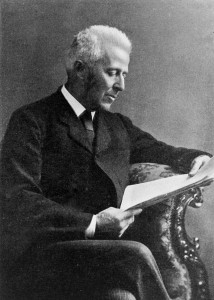
Joseph Bell – Inspiration for Sherlock Holmes
1879 – Conan Doyle’s work is published for the first time . The story is The Mystery of the Sasassa Valley .
1880 – He serves as ship’s surgeon on the Greenland whaler Hope.
1881 – A Bachelor of Medicine and Master of Surgery are awarded to Conan Doyle. He leaves from Liverpool to serve as shipboard medical officer on the steamer Mayumba.
1882 – Conan Doyle leaves for Portsmouth to establish his own medical practice.
1883 – He joins the Portsmouth Literary and Scientific Society.
1884 – J. Habakuk Jephson’s Statement is published.
1885 – On August 5th, Conan Doyle marries Louise “Toulie” Hawkins .
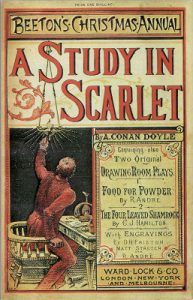
1887 – A Study in Scarlet , the first Sherlock Holmes story, is published.
1889 – Mary, the first child of Conan Doyle, is born. Micah Clarke is published.
1890 – The Sign of Four is published.
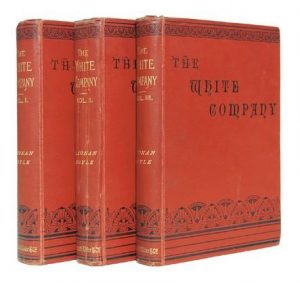
1891 – Conan Doyle gives up his medical practice in favor of writing. The White Company is published.
1892 – Louise gives birth to Arthur Allyne Kingsley. The Adventures of Sherlock Holmes is published.
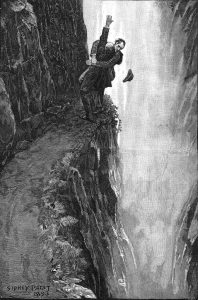
1893 – Conan Doyle visits Reichenbach Falls. Louise is diagnosed with tuberculosis. Conan Doyle’s father, Charles , dies. Conan Doyle takes Louise to Switzerland because of her health. Conan Doyle joins the British Society for Psychical Research. The Adventure of the Final Problem is published.
1894 – The Memoirs of Sherlock Holmes is published. Conan Doyle goes on a lecture tour of the United States.
1895 – Visits Egypt
1896 – Conan Doyle and family move back to England.
1897 – Conan Doyle meets Jean Leckie, the woman who would later become his second wife .
1899 – A Duet with an Occasional Chorus is published.
1900 – Serves in the Boer War.
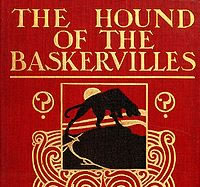
1901 – The Hound of the Baskervilles is published in The Strand magazine.
1902 – The War in South Africa: Its Causes and Conduct is published. Conan Doyle is knighted for this publication.
1904 – Conan Doyle is made a member of the Crimes Club. The Return of Sherlock Holmes is published.
1905 – Sir Nigel is published.
1906 – Louise dies at the age of forty-nine. Conan Doyle begins the investigation of the George Edalji case .
1907 – Conan Doyle marries Jean Leckie .
1909 – Denis Percy Stewart Conan Doyle is born to Jean and Arthur. Conan Doyle writes The Crime of the Congo .
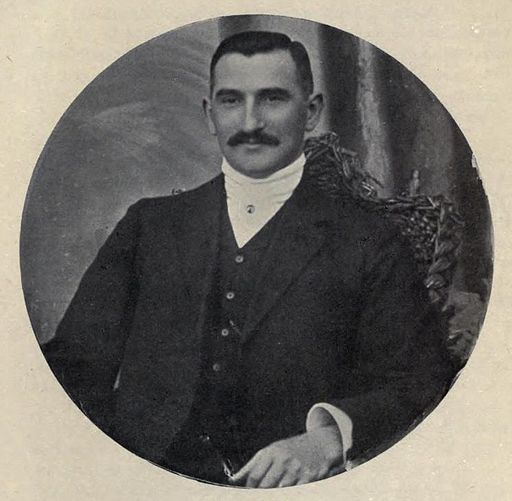
Oscar Slater in 1908
1910 – Conan Doyle becomes involved in the Oscar Slater case . Adrian Malcom is born to Jean and Arthur.
1911 – Conan Doyle and Jean take part in the Prince Henry Tour .
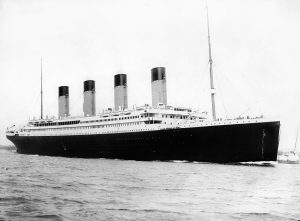
1912 – The Lost World is published. Lena Jean Annette is born to Jean and Arthur. Conan Doyle argues with George Bernard Shaw about the Titanic .
1913 – The Poison Belt is published.
1914 – Conan Doyle visits the United States.
1915 – The Valley of Fear is published in book form.
1916 – Conan Doyle declares his belief in Spiritualism in the Light magazine.
1917 – Conan Doyle speaks publicly on Spiritualism for the first time. His Last Bow is published.
1918 – His son, Kingsley, dies. His brother, Innes, also dies.
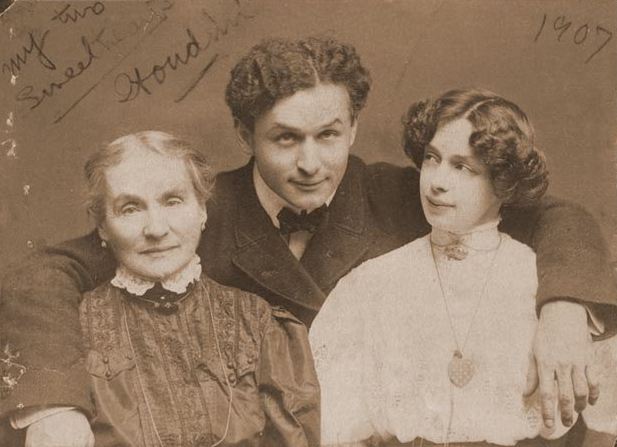
“My Two Sweethearts”—Houdini with his mother and wife around 1907
1920 – Conan Doyle writes about the Cottingley fairies in the December issue of The Strand . Conan Doyle meets Houdini .
1921 – Jean Conan Doyle discovers that she has the ability to do automatic writing.
1922 – The Coming of the Fairies is published. Jean Conan Doyle attempts to contact Houdini’s mother.
1925 – The Lost World is made into a film. The Land of Mist is published.
1926 – History of Spiritualism is published.
1927 – The Case-Book of Sherlock Holmes is published.
1928 – Conan Doyle launches a five-month tour of Africa.
1930 – Sir Arthur Conan Doyle dies on July 7. They bury him at the rose garden in Windlesham.
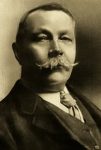
Screen Rant
Arthur conan doyle's 10 best sherlock holmes stories.

Your changes have been saved
Email Is sent
Please verify your email address.
You’ve reached your account maximum for followed topics.
10 Biggest Ways Benedict Cumberbatch's Sherlock Holmes Changes The Original Character
8 sherlock stories that can only be wrapped up in season 5 (or a movie), every actor who played sherlock holmes (in movies & tv).
- Doyle's incredible stories introduced Sherlock Holmes as a genius detective taking on remarkable cases, each featuring memorable characters and plots.
- The Final Problem shocked readers with the death of Holmes by the hands of Professor Moriarty but Doyle resurrected him due to popular demand.
- Holmes' adventures continue to inspire adaptations like the BBC's Sherlock, honoring the classic tales while adding new twists to captivate modern audiences.
Arthur Conan Doyle is one of the most visionary and prolific writers of all time, and the creator of the ever popular Sherlock Holmes series of stories. ACD began publishing stories about the renowned detective in 1887, when he released his first novel, A Study in Scarlet . Then, in 1891, he began to compile and publish short stories revolving around Holmes within The Strand Magazine which ended up having record sales as a result of his collected works appearing regularly in the magazine.
Altogether, the detective appears in four novels, and 56 short stories, which all see Holmes set about to work on various cases. Holmes uses his remarkable skills of reasoning and determination to accurately solve and detect things that most other people fail to observe and understand. His gifted mind and remarkable intelligence make him one of the greatest detectives of all time, but he is also an eccentric figure who has several unsavory quirks.
10 The Final Problem
The Final Problem is one of the most remarkable short stories to ever feature Detective Holmes as it was initially written to create an end for the series. The story introduces the great villain, Professor Moriarty , and features the death of the hero, Holmes, within its narrative. However, Doyle did eventually choose to pick up his pen once again and continue telling stories around his greatest ever work. This story is so profound and prolific, due to the presence of the incredible villain that is now well-established in popular media as Sherlock's greatest rival.
In the 2011 film starring Robert Downey Jr. as Sherlock, Sherlock Holmes: A Game of Shadows , the film ends with a scene which replicates Holmes' fate in the short story, falling over the edge of the cliff along with Moriarty. The popular BBC show, Sherlock , also featured an amalgamation of stories where Moriarty was present, drawn from inspirations in the works by Doyle, and titled the final episode of the series with "The Final Problem" as a tribute, despite the story being very different.
Sherlock: The 10 Best Quotes From The Show
Sherlock is undoubtedly one of the BBC's finest works, boasting some brilliant quotes penned by talented writers and delivered by excellent actors.
9 The Adventure Of The Musgrave Ritual
In general, the stories about Sherlock Holmes written by Doyle were all written through the perspective of his dear friend, Dr. John Watson . While this is true for almost all of the stories, there are a small number that deviate from tradition. The Adventure of the Musgrave Ritual is one such example, where Sherlock himself takes the lead in recording and recounting the story.
This story is a brilliant example of Holmes' exceptional skills at deduction and problem-solving. When presented with an old, mysterious poem, Holmes is able to dig deeper into the source material and gain insight about the meaning and solve a centuries-old mystery. The story is full of intrigue and mystery, until Holmes makes the events clear and plain in his typical manner.
8 A Study In Scarlet
The very first story about Sherlock Holmes came in 1887, in a full-length novel titled A Study in Scarlet . Doyle only ever wrote four novels about Holmes in total, with most of the other stories detailing his adventures existing in the form of short stories. However, this first story was already a very full and clear idea of the character and the world around him which has endured to this day.
The relationship between Holmes and his friend Watson are developed within the narrative, along with the introduction of prominent returning characters like Inspector Lestrade . The story is also the first work of detective fiction to use a magnifying glass within the investigation, which became an intrinsically linked idea to the character of Holmes. Finally, it also reveals how and why Watson chose to record Holmes' adventures, establishing the canon that would take the character far beyond this novel.
7 Problems A Sherlock Movie With Benedict Cumberbatch Would Need To Overcome
Co-creator Mark Gatiss has stated that he is still keen on making a Sherlock movie, but there are some significant hurdles to overcome.
7 The Sign Of The Four
The Sign of the Four was Doyle's next entry into the narrative of Sherlock Holmes, and the second of his four novels, released in 1890. This story steps up the mystery and intrigue with a secret treasure and letters being sent with gifts by anonymous authors. As the story unfolds, it appears that more and more people are tied up in secret activities, but many are now dead, or unaware of the extent of what is going on.
This novel is the second and last time that Holmes' Baker Street Irregulars are used to help him unravel the mystery by employing the large group of homeless children. However, later stories would include one or two individual children working to aid Holmes. It also introduces Mary Morstan, who would become Watson's wife, and a recurring character in later stories.
6 The Adventure Of The Blue Carbuncle
The Adventure of the Blue Carbuncle is a simple short story which was first published in The Strand Magazine in 1892, but it contains all of the signature elements that mark a Sherlock Holmes story to this day. The mystery revolves around a hat and a goose found together on the street. The goose has a tag which indicates it belongs to a Mr. Henry Baker, but due to how common that name is, it requires a professional sleuth to uncover their identity.
While the case seems less profound than Holmes' typical workload, he is able to make connections that identify the owner based on the most minute details. The story is fun and simple, while also revealing the extent of Holmes' powers of deduction. And it leads to a much larger mystery than a simple found goose as the events unfold.
Cumberbatch modernized Sherlock Holmes in the BBC’s interpretation of the famous detective, but there are some big changes to the original character.
5 The Adventure Of Silver Blaze
Silver Blaze is among the most beloved stories of Sherlock Holmes by Doyle himself. The short story was initially released in 1892, and it revolved around an exceptional race horse who disappeared. In addition to the horse vanishing, a man has been murdered. The story excels at building details throughout, before finally tying everything together for the story's epic reveal at the end.
Holmes visits Dartmoor, where he has been summoned to work on this case. In his investigation, he finds a series of unusual details that could be written off as unconnected or unimportant, but Holmes' keen eye and discerning mind cause him to find connections where others overlook them. Holmes finally discovers the truth behind the murder and the horse's disappearance, and reveals everything in an exciting and engaging monologue.
4 A Scandal In Bohemia
A Scandal in Bohemia is Doyle's third Holmes story overall, and the first short story ever released. It is famous for introducing another of the most popular characters to ever appear in Sherlock Holmes stories, Irene Adler , who frequently features in adapted works. However, in Doyle's writing, this is the only story in which she makes an appearance.
When the King of Bohemia is set to marry his fiancée, he fears that she will find out about an affair he had several years earlier with a woman named Irene Adler. Adler has a photo of them as a couple, which is the only evidence that remains of their relationship, and he hires Sherlock to recover the photo. While Sherlock is able to find Adler, locate the photo, and set up a plan to retrieve it, Adler outmaneuvers him, and escapes with the original picture, leaving one of herself in its place with a letter to Holmes.
If BBC’s Sherlock were to return with a season 5, or even a movie, these are the storylines that fans would most like to see from the series.
3 The Red-Headed League
The Red-Headed League was another early short story by Doyle about a mysterious organization that employed and provided for red-headed men by way of performing simple tasks. The premise is incredibly intriguing and witty, and it provides the rest of the story with plenty of intrigue. However, once Holmes is called in, it's only a matter of time before the mystery is solved.
Holmes takes as many details as he can from the man who was employed in this unusual red-headed league before it suddenly closed. With descriptions, and his powers of reasoning, Holmes starts to put the pieces together long before anyone else, and takes them into a bank vault where everyone is wondering why they are there. Then, the criminals behind the league pop up through the floor of the vault, and Holmes reveals his conclusions which led him to discover their crime before it happened.
2 The Hound Of The Baskervilles
The Hound of the Baskervilles is Doyle's third novel, which was initially released in serial format through The Strand Magazine . The parts were released in monthly installments between August 1901 and April 1902, and following this, the complete story was compiled and released as a novel. What makes this story distinct from the others is the fact that it served as a revival for the character after his intended final adventure in The Final Problem .
The story is incredibly compelling and widely regarded as the best and most popular of the four novels. While the mystery intially appears to be supernatural in nature, Doyle does a tremendous job at taking the story down a logical path which explains the unexplainable. Much of the story follows Watson as he embarks on an investigation of his own ahead of Sherlock, but when the team is reunited, the case rapidly races toward its conclusion.
Sherlock Holmes is a classic character in TV and movies. Here are all of the actors who have played Sherlock Holmes, both in movies and on TV.
1 The Speckled Band
The Speckled Band is one of the best stories ever written by Doyle, with a clever mystery at its center. A young woman named Helen Stoner approaches Holmes for help, and recites her troubling life story and the relationship with her abusive father. As the story develops, it appears that there may be supernatural elements at play. However, Holmes' impeccable insights reveal the truth.
Holmes conducts a thorough investigation of where the mystery and previous deaths have occurred, and he gathers all of the facts together. Doyle proves his remarkable skill for building mystery mysteries, which is only fully revealed at the last moment, while building the narrative in a way that can only be explained by supernatural means. This subversion and intrigue is just one part of the incredible storytelling that helped to make Doyle's Sherlock Holmes so spectacular and gripping from start to finish.

The Eventful Life of Sir Arthur Conan Doyle
S ir Arthur Conan Doyle is remembered today as an author and the creator of Sherlock Holmes, one of the most iconic fictional characters of all time. This, however, was just one role Doyle undertook during his long and eventful life – and one that he came to resent as time moved on. As well as being a writer, he was also an accomplished (though failed) doctor, a keen sportsman, and a would-be politician, among many other things. Here, we will explore the story of Sir Arthur Conan Doyle himself, tracing the highs and lows of his extraordinary life.
A Difficult Start: Doyle’s Early Life
Arthur Ignatius Conan Doyle was born in Edinburgh, Scotland, on 22nd May 1859 to Mary Doyle (née Foley), an Irish Catholic, and Charles Altamont Doyle, who was born in England but was of Irish Catholic heritage. His father came from an artistic family and followed the family tradition, working as an artist and a civil servant, though his fame would come to be eclipsed by his son’s.
By 1864, however, the family’s fortunes were in disarray, and the Doyle family itself was scattered across Edinburgh due to Charles Altamont Doyle’s struggles with alcohol addiction . During this time, Arthur Conan Doyle stayed with the reformer Mary Burton, who was the aunt of a school friend. Three years later, the family was once again living together under one roof, though in vastly reduced circumstances, taking up residence in an Edinburgh tenement flat.
Due to his father’s reduced circumstances and failing physical and mental health, Arthur Conan Doyle’s education was paid for by his comparatively affluent relatives. He attended private Roman Catholic schools in England, the first being the Jesuit preparatory school in Stonyhurst, Lancashire, from 1868 to 1870. From here, he went on to Stonyhurst College (of which he had few happy memories) before leaving in 1875 to spend a year studying at the Stella Matutina in Fedlkirch, Austria, to improve his German language skills. Though the Stella Matutina was also a Jesuit school, it was considerably less strict than his previous Lancashire schools had been, and it was here that he lost his faith and became an agnostic.
Hard Luck: Doyle’s Medical Career & First Forays into Writing
After leaving the Stella Matutina, Doyle enrolled at the University of Edinburgh Medical School, where he also studied botany at the Royal Botanic Garden in Edinburgh alongside his medical degree. In addition, he wrote fiction as a medical student, with his first published story, “The Mystery of Sasassa Valley,” appearing in Chambers’s Edinburgh Journal in 1879. During that same year, he also published his first academic article, “Gelsemium as a Poison,” in the British Medical Journal .
Thus, we can see how Doyle would later put his medical training to use in constructing murder mysteries for Holmes and Watson to solve. He also famously based Sherlock Holmes on his Edinburgh university lecturer Joseph Bell. The likeness between the two was immediately obvious to fellow Edinburgh man of letters Robert Louis Stevenson , who was a friend of Bell.
A year after these publications appeared, Doyle worked as a doctor on the Greenland Whaler Hope of Peterhead in 1880. The following year, he graduated with a Bachelor of Medicine and a Master of Surgery from the University of Edinburgh. His time aboard the Hope of Peterhead had presumably given him a taste for life on the open sea, however, and he soon put his master’s degree to good use by becoming the ship’s surgeon on the SS Mayumba on a voyage to the coast of West Africa.
Upon returning to England in 1882, he made two abortive attempts to set up a medical practice in Plymouth and Portsmouth, respectively. (A decade later, he faced similarly bad luck when trying to set up a practice in London). He returned, therefore, to the University of Edinburgh, where he was awarded his MD in 1885, writing his dissertation on tabes dorsalis . While he struggled to make a living as a professional doctor, it is clear that Doyle was a highly intelligent man of science who was fully engaged in the medical debates of his time. He was a keen proponent of compulsory vaccination, for example, and was deeply interested in ophthalmology.
He had a similarly difficult time trying to make money from his writing. Though he made his name through his writings on Sherlock Holmes and Doctor Watson, the first novels Doyle wrote are, in fact, The Mystery of Cloomber (which was not published until 1888) and The Narrative of John Smith , which he did not finish and was only published posthumously in 2011.
After writing A Study in Scarlet – the first work to feature Holmes and Watson – in just three weeks, however, he did manage to secure a publication deal with Ward, Lock & Co., but, as a young and relatively unknown writer, he was paid just £25 for the story and all rights to it. In 1887, the novel was published in Beeton’s Christmas Annual . Having received positive reviews, a sequel was commissioned by Ward, Lock & Co., which in turn led to the serial publication of The Sign of the Four in Lippincott’s Magazine in 1890. By this time, however, Doyle had become increasingly aware of the exploitation of his work under Ward, Lock & Co., with whom he severed ties.
This Sporting Life
One aspect of Doyle’s life that is less well-known is his keen interest in sports. His main sporting passion was cricket , playing ten first-class matches for the Marylebone Cricket Club between 1899 and 1907. He also played for amateur cricket teams, including the Authors XI, which also included P.G. Wodehouse, A.A. Milne , and fellow Scott J.M. Barrie.
Perhaps more surprisingly, Doyle established the Undershaw Rifle Club after installing a 100-yard shooting range at his home. The range was open to men in the local area, as Doyle believed that the recent Boer War had demonstrated that British marksmanship left a lot to be desired. (In 1900, Doyle had been a volunteer physician in the Langman Field Hospital in Bloemfontein during the Second Boer War and went on to write The Great Boer War and The War in South Africa: Its Cause and Conduct that same year. It was for this, Doyle believed, he was knighted in 1902). He would later go on to be part of the Rifle Clubs Committee of the National Rifle Association.
As well as this, Doyle was also interested in boxing and bodybuilding. While he was an amateur boxer, his interest in bodybuilding was that of an outsider rather than an active participant. In fact, in 1901, he was among the three judges of the first-ever major bodybuilding competition, held at the Royal Albert Hall in London.
And, like many others in the late nineteenth and early twentieth centuries, Doyle was also interested in the Alps and Alpine sports, especially skiing. In December 1894, his article “An Alpine Pass on ‘Ski’” was printed in The Strand Magazine . Here, he outlined his own passion for skiing, waxing lyrical on the sublime alpine landscape that could be appreciated from the slopes.
Though born in Edinburgh, Doyle was of Irish Catholic descent and, though he later turned to mysticism, was brought up Roman Catholic. The question of Irish independence was a key political issue of the time, with Doyle (a Liberal Unionist) favoring British rule in Ireland.
Doyle, however, was a supporter of the campaign movement for the reform of the Congo Free State, spearheaded by the journalist E.D. Morel and the diplomat and Irish nationalist Roger Casement. Through his support of this cause, he came to know both Morel and Casement.
Following his work in Africa, Casement returned to Ireland in 1904 and joined the Gaelic League and, a year later, joined Arthur Griffith’s newly founded Sinn Féin. In support of the 1916 Easter Rising , Casement smuggled German arms and ammunition into Ireland for the rebels’ use. He was subsequently found guilty of treason and sentenced to death. Though Doyle was a unionist, he argued that Casement was mad and so not liable for his actions. Doyle’s pleas were in vain, however, and Casement was hanged.
In the lead-up to the First World War , Doyle donated ten shillings to the British Brothers’ League, an anti-immigration, proto-fascist pressure group whose views gained traction among a British public gripped by Germanophobia. However, Doyle was also involved in the case of Oscar Slater, a German Jewish man wrongly accused of murdering an 82-year-old woman in Glasgow in 1908. In 1912, Doyle (who, in 1903, founded the Crimes Club, in which members discussed crimes, criminals, and detection) published The Case of Oscar Slater , in which he marshaled the available evidence to argue that Slater was innocent. He continued to raise the matter publicly and paid the majority of the legal fees Slater incurred during his successful 1928 appeal.
Sir Arthur Conan Doyle’s Death & Legacy
Sir Arthur Conan Doyle died suddenly of a heart attack at age 71 at his home in East Sussex. In many ways, his life was a series of apparent contradictions. Educated at private, fee-paying schools, his childhood was marked by financial instability due to his father’s ongoing struggles with alcoholism. An accomplished and trained physician, he failed to establish a career in medicine, and after finding fame as an author, he came to resent his greatest creation. He struggled to decide where he stood on the issue of freemasonry, joining and abandoning the order on more than one occasion. And while on one occasion he publicly supported the far-right and deeply xenophobic British Brothers’ League, he was also appalled by the miscarriage of justice in Oscar Slater’s case, which led to a German-born Jewish man being imprisoned for twenty years for a crime he had not committed. Doyle, then, was not an uncomplicated figure, and his life was a tale of extreme highs and lows that could have rivaled the narrative arc of even his most ambitious works of fiction.


IMAGES
VIDEO
COMMENTS
Sir Arthur Ignatius Conan Doyle KStJ, DL (22 May 1859 - 7 July 1930) was a British writer and physician. He created the character Sherlock Holmes in 1887 for A Study in Scarlet, the first of four novels and fifty-six short stories about Holmes and Dr. Watson.The Sherlock Holmes stories are milestones in the field of crime fiction. Doyle was a prolific writer; other than Holmes stories, his ...
Arthur Conan Doyle (born May 22, 1859, Edinburgh, Scotland—died July 7, 1930, Crowborough, Sussex, England) was a Scottish writer best known for his creation of the detective Sherlock Holmes —one of the most vivid and enduring characters in English fiction. Conan Doyle, the second of Charles Altamont and Mary Foley Doyle's 10 children ...
In 1890, Arthur Conan Doyle's novel, A Study in Scarlet introduced the character of Detective Sherlock Holmes. Doyle would go on to write 60 stories about Sherlock Holmes. He also strove to spread ...
Biography Childhood. Birth, Family. Arthur Conan Doyle was born on 22 may 1859, at Picardy Place, Edinburgh, Scotland. His mother, Mary Josephine Foley, was Irish and descendant of the famous Percy family of Northumberland, in the line of Plantagenet.His father, Charles Altamont Doyle, was a not very ambitious officer with some artistic talent .When he lost his job, he sank into alcoholism and ...
Sir Arthur Conan Doyle (22 May 1859 - 7 July 1930) - Scottish writer, physician and spiritualist - best known for his Sherlock Holmes stories. Sir Arthur Conan Doyle was born in Picardy Place, Edinburgh, Scotland in 1859. At school, he developed a talent for storytelling in the dormitories after lights. He nursed ambitions to […]
Arthur Conan Doyle was born on 22 May 1859 in Edinburgh into a prosperous Irish family. He trained as a doctor, gaining his degree from Edinburgh University in 1881. He worked as a surgeon on a ...
Arthur Conan Doyle's humble beginnings did not predict his future success. Born on May 22, 1859, to a middle-class, Catholic family, he grew up on Edinburgh's rough-and-tumble streets, far from his successful grandfather and uncles, who hobnobbed with London's intellectual elite.
Arthur Conan Doyle (1859-1930) Arthur Ignatius Conan Doyle was born in Edinburgh, Scotland, on May 22, 1859, the third of ten children of an Irish painter who specialized in fantasy scenes. Conan Doyle was sent to England at age nine to attend Jesuit boarding school, an experience he loathed. At the school, however, he exhibited a talent for ...
Arthur Conan Doyle KStJ, DL (1859-1930) was a Scottish writer and physician. In addition to the series of stories chronicling the activities of Sherlock Holmes and his friend Dr John Watson for which he is well known, Doyle wrote on a wide range of topics, both fictional and non-fictional. In 1876 Doyle entered the University of Edinburgh Medical School, where he became a pupil of Joseph ...
Sir Arthur Ignatius Conan Doyle KStJ, DL (22 May 1859 - 7 July 1930) was a British writer and physician. He created the character Sherlock Holmes in 1887 for A Study in Scarlet, the first of four novels and fifty-six short stories about Holmes and Dr. Watson. The Sherlock Holmes stories are milestones in the field of crime fiction.
The Arthur Conan Doyle Encyclopedia is an online repository of all works written by Sir Arthur Conan Doyle ( fictions, essays, articles, poems, plays, lectures, letters, manuscripts ...), but also any materials related to him ( newspaper articles, interviews, photos, movies ...). His Life. His Works. Adaptations.
Arthur Conan Doyle. Like the elusive Sherlock Holmes, his most famous creation, Sir Arthur Conan Doyle was a man of many contradictions. Scientifically educated, he believed in séances and fairies. An advocate for more equitable divorce laws, he believed that women should be denied the vote. A humanist who identified with oppressed peoples, he ...
The Lost World. Signature. Sir Arthur Conan Doyle (22 May 1859 - 7 July 1930) was a British doctor and author. [1] [2] He is well known because he wrote short stories about the detective Sherlock Holmes. He also wrote science fiction and historical stories. He became an agnostic by the time he left school.
Ancestors. Sir Arthur Conan Doyle as a child, with his father Charles Altamond (Adcock 96). The Doyle family originated in Ireland and were dedicated Roman Catholics. Arthur Conan Doyle's grandfather, John Doyle (c. 1797-1868), a tailor, was born in Dublin into a devoutly Catholic family. All John's siblings entered Catholic religious orders ...
Arthur Conan Doyle, detail of a portrait by H.L. Gates, 1927; in the National Portrait Gallery, London. Sir Arthur Conan Doyle, (born May 22, 1859, Edinburgh, Scot.—died July 7, 1930, Crowborough, Sussex, Eng.), Scottish writer. He became a doctor and practiced until 1891, studying with Dr. Joseph Bell, who was the model for his fictional ...
Arthur Conan Doyle (May 22, 1859 - July 7, 1930) created one of the world's most famous characters, Sherlock Holmes. But in some ways, the Scottish-born author felt trapped by the runaway popularity of the fictional detective. Over the course of a long writing career, Conan Doyle wrote other stories and books he believed to be superior to the ...
Introduction. Sir Arthur Conan Doyle (b. 1859-d. 1930) was a Scottish physician, writer, and spiritualist most famous for being the creator of Sherlock Holmes. Extraordinarily prolific and multifaceted, Conan Doyle composed not only the Sherlock Holmes fiction, which comprises four novels and fifty-six short stories, but also fictional series ...
Arthur Conan Doyle was born in Edinburgh, Scotland, on May 22, 1859. He was the oldest son of Charles Doyle, a civil servant. His parents were Irish Roman Catholics, and he received his early education in a Jesuit school, Stonyhurst. Later he got a medical degree at Edinburgh University. He started practice as a family physician in Southsea ...
Sherlock Holmes, fictional character created by the Scottish writer Arthur Conan Doyle.The prototype for the modern mastermind detective, Holmes first appeared in Conan Doyle's A Study in Scarlet, published in Beeton's Christmas Annual of 1887; the first collection of the Holmes' tales, published as The Adventures of Sherlock Holmes, appeared in 1892.
Conan Doyle was born in Scotland on May 22, 1859. He passed away on July 7, 1930. Between those two days, he led quite a life! This online biography covers both the professional and private life of Sir Arthur Conan Doyle.
Sherlock Holmes (/ ˈ ʃ ɜːr l ɒ k ˈ h oʊ m z /) is a fictional detective created by British author Arthur Conan Doyle.Referring to himself as a "consulting detective" in his stories, Holmes is known for his proficiency with observation, deduction, forensic science and logical reasoning that borders on the fantastic, which he employs when investigating cases for a wide variety of clients ...
Arthur Conan Doyle is one of the most visionary and prolific writers of all time, and the creator of the ever popular Sherlock Holmes series of stories. ACD began publishing stories about the renowned detective in 1887, when he released his first novel, A Study in Scarlet.Then, in 1891, he began to compile and publish short stories revolving around Holmes within The Strand Magazine which ended ...
Born on May 22, 1859, in Edinburgh, Scotland, Conan Doyle's influence reaches far beyond his iconic detective stories.S ir Arthur Conan Doyle Biography and Works. Early Life and Education: Conan Doyle hailed from an artistic Catholic family, with his father, Charles Altamont Doyle, being an artist, and his mother, Mary Foley, a vibrant ...
Sir Arthur Conan Doyle died suddenly of a heart attack at age 71 at his home in East Sussex. In many ways, his life was a series of apparent contradictions. Educated at private, fee-paying schools ...
Arthur Ignatius Conan Doyle (Edimburgo, 22 de mayo de 1859-Crowborough, 7 de julio de 1930) [1] fue un escritor y médico británico de ascendencia irlandesa, [2] creador del célebre detective de ficción Sherlock Holmes. Fue un autor prolífico cuya obra incluye relatos de ciencia ficción, novela histórica, teatro y poesía.
The Lost World is a science fiction novel by British writer Sir Arthur Conan Doyle, published by Hodder & Stoughton in 1912, concerning an expedition to a plateau in the Amazon basin of South America where prehistoric animals still survive. It was originally published serially in the Strand Magazine and illustrated by New-Zealand-born artist Harry Rountree during the months of April-November ...
Arthur Ignatius Conan Doyle (22 de mayu de 1859, Edimburgu - 7 de xunetu de 1930, Windlesham Manor (en)) foi un escritor y médicu británicu, creador del célebre detective de ficción Sherlock Holmes. Foi un autor prolíficu que la so obra inclúi rellatos de ciencia ficción, novela histórica, teatru y poesía.